This creamy, mild vegetarian yellow curry is packed with vegetables and can be made from scratch in about 30 minutes.
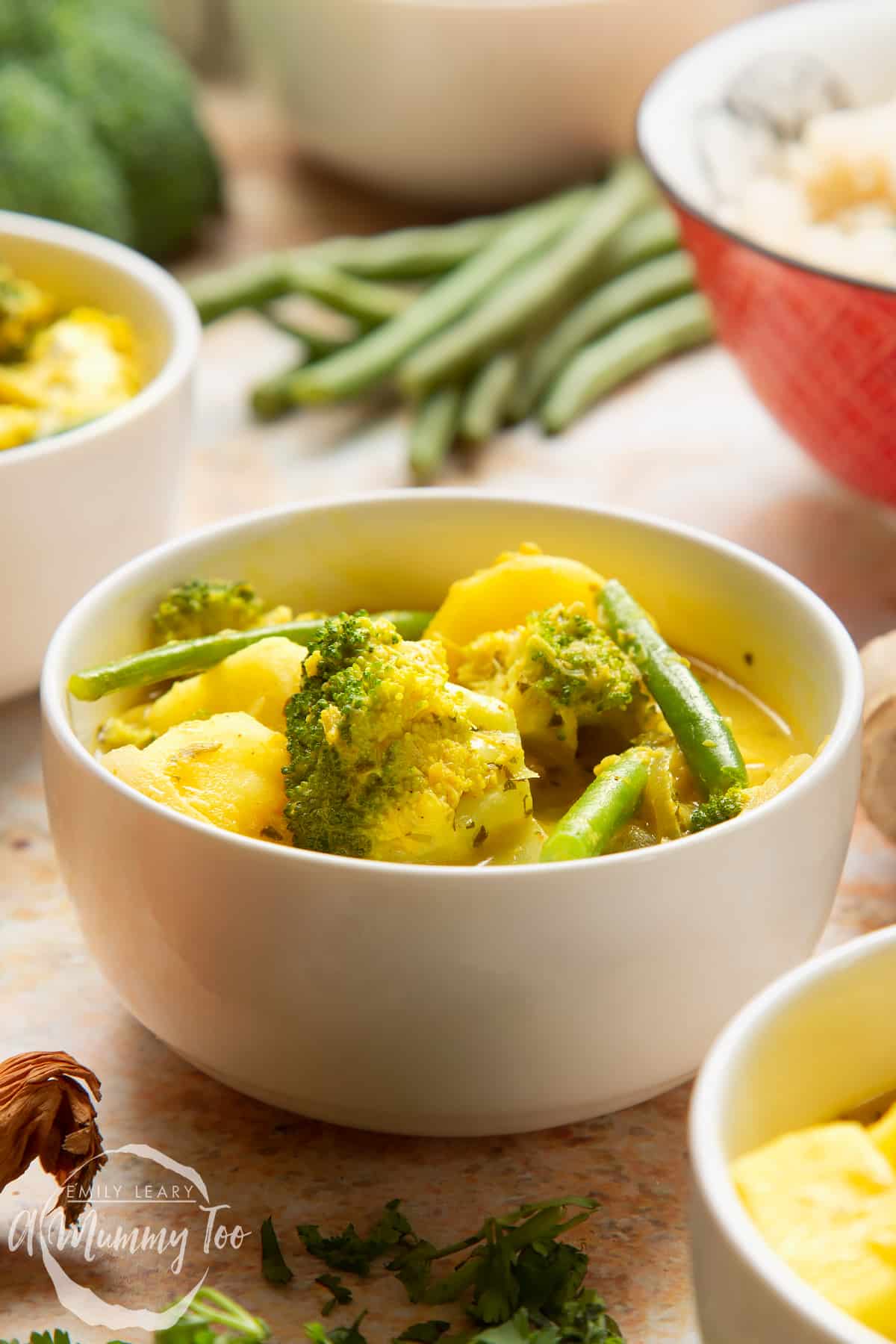
Using onions, garlic and spices, you'll make your own vegetarian yellow curry paste in your food processor before frying with onion, combining with coconut milk and simmering with broccoli, potato and green beans.
If you love Thai flavours, but find red or green Thai curry a little too hot, this is the recipe for you.
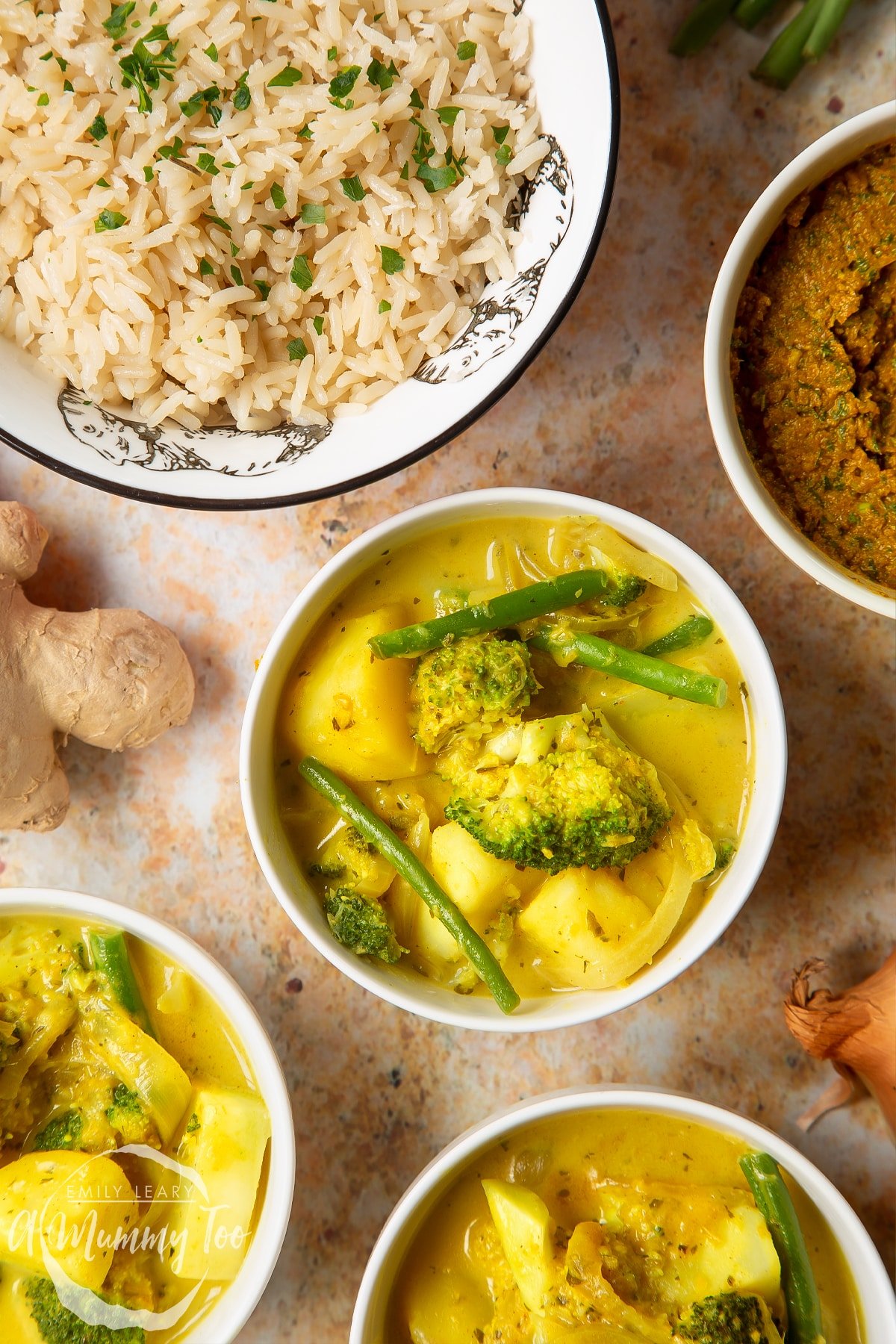
Here's how to make four small bowls or two larger bowls of vegetarian yellow Thai curry.
(Note: if you prefer a saucier curry, you can double the quantities of paste, onions and coconut used, while keeping the quantity of potatoes, green beans and broccoli the same.)
Ingredients
For the vegetarian yellow curry paste
- ½ (1/2) onion roughly chopped
- 15 g (0.5 oz) fresh root ginger peeled and chopped
- 2 cloves garlic
- 15 g (0.5 oz) fresh coriander (cilantro) roughly chopped including stalks
- 1 stick lemongrass roughly chopped
- ½ tsp (1/2 tsp) ground cumin
- 1 tsp turmeric powder
- ½ tsp (1/2 tsp) fenugreek
- ½ tsp (1/2 tsp) cayenne pepper
- ¼ tsp (1/4 tsp) cinnamon
- 1 tsp soft light brown sugar
- ½ (1/2) lime juiced
- ½ tbsp (1/2 tbsp) soy sauce or gluten free alternative
For the vegetarian yellow curry
- 1 tbsp vegetable oil (canola oil)
- ½ (1/2) onion peeled and thinly sliced
- 400 g (14.1 oz) canned coconut milk
- ½ head (1/2) broccoli chopped into florets including the stalk
- 2 medium potatoes peeled and chopped into bitesize pieces
- 75 g (2.6 oz) green beans topped and tailed
- Pinch salt and black pepper
Instructions
Make the vegetarian yellow curry paste
Put the onion, ginger and garlic into a food processor.
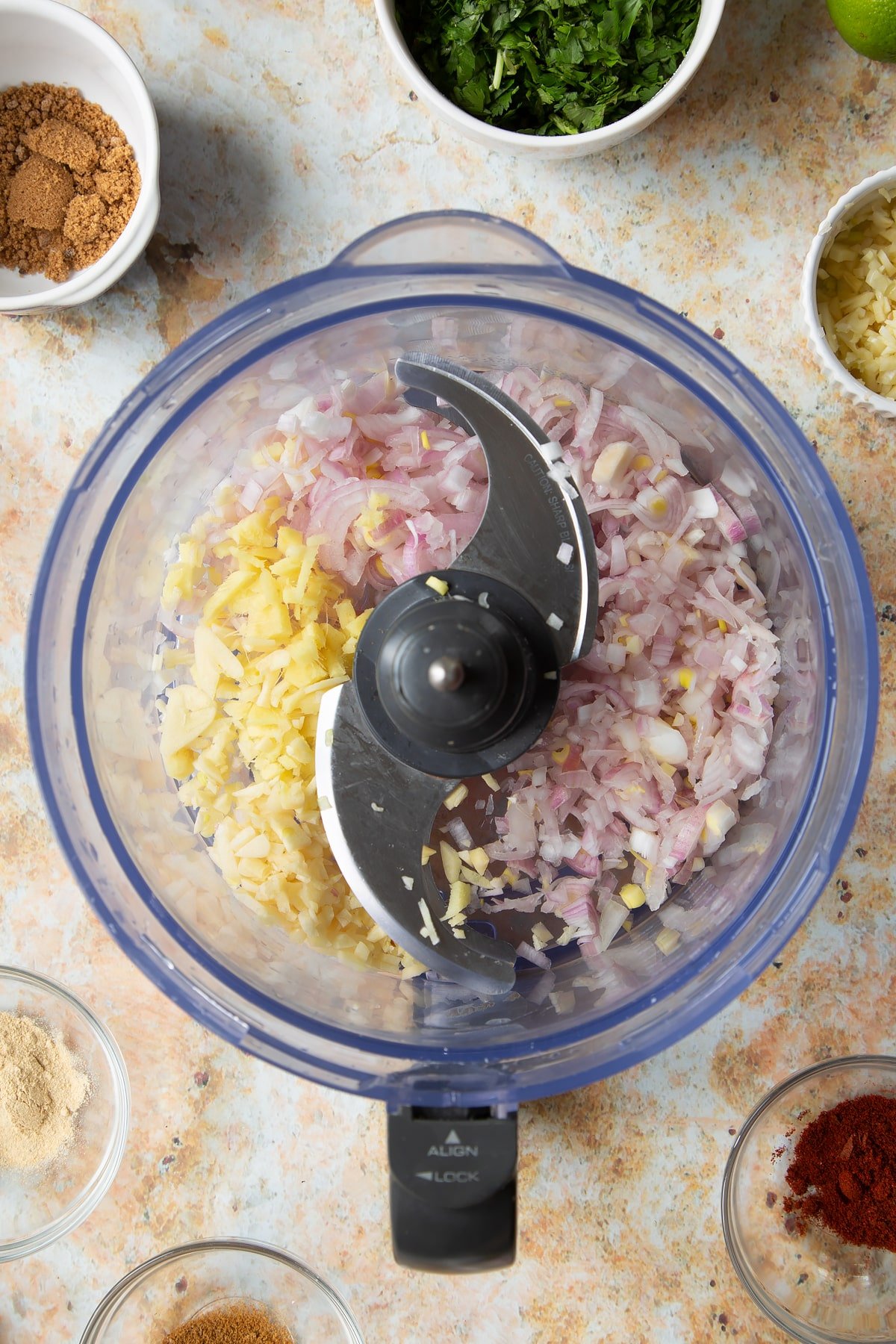
Add the coriander and lemon grass.
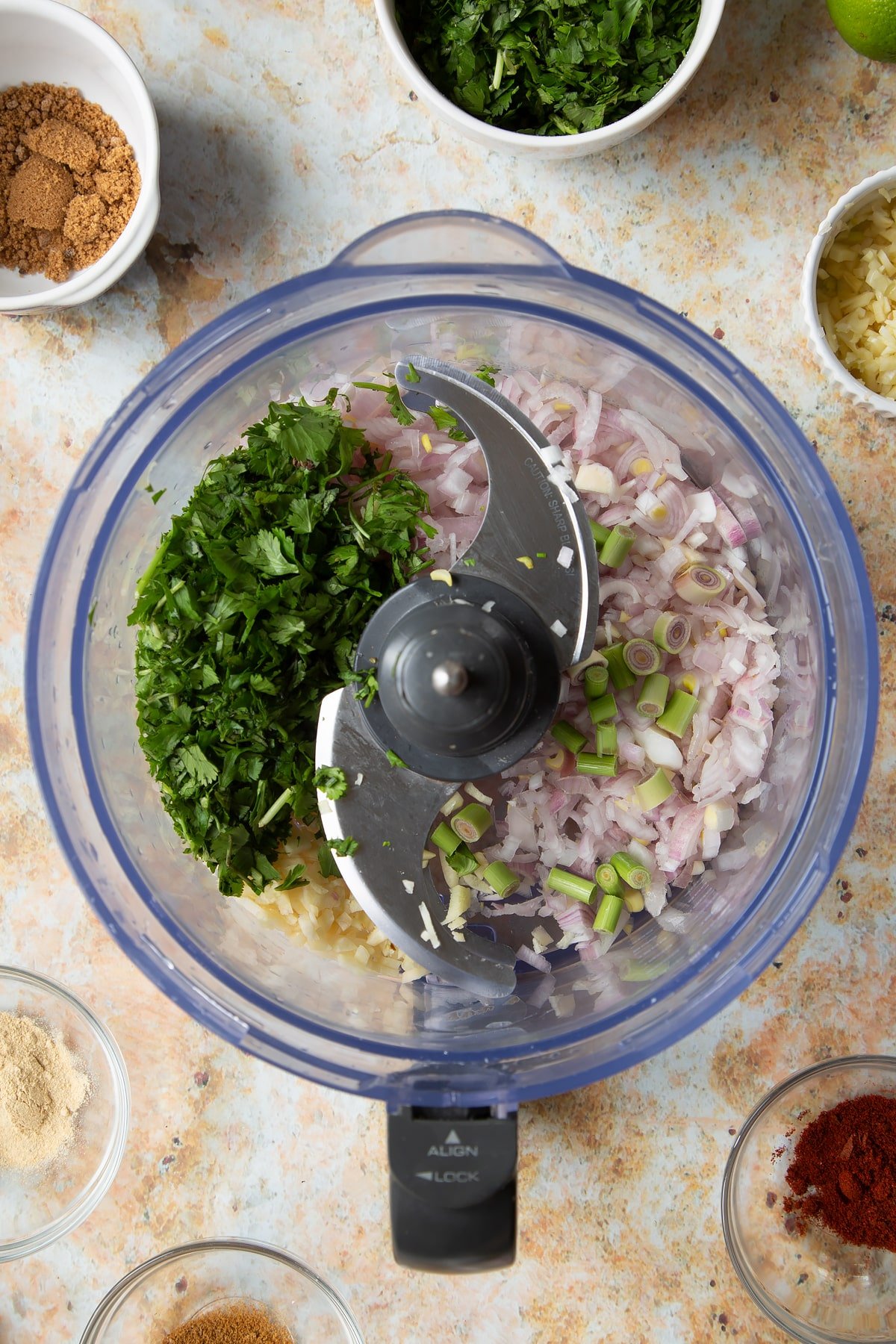
Add the cumin, turmeric, fenugreek, cayenne pepper, cinnamon and brown sugar.
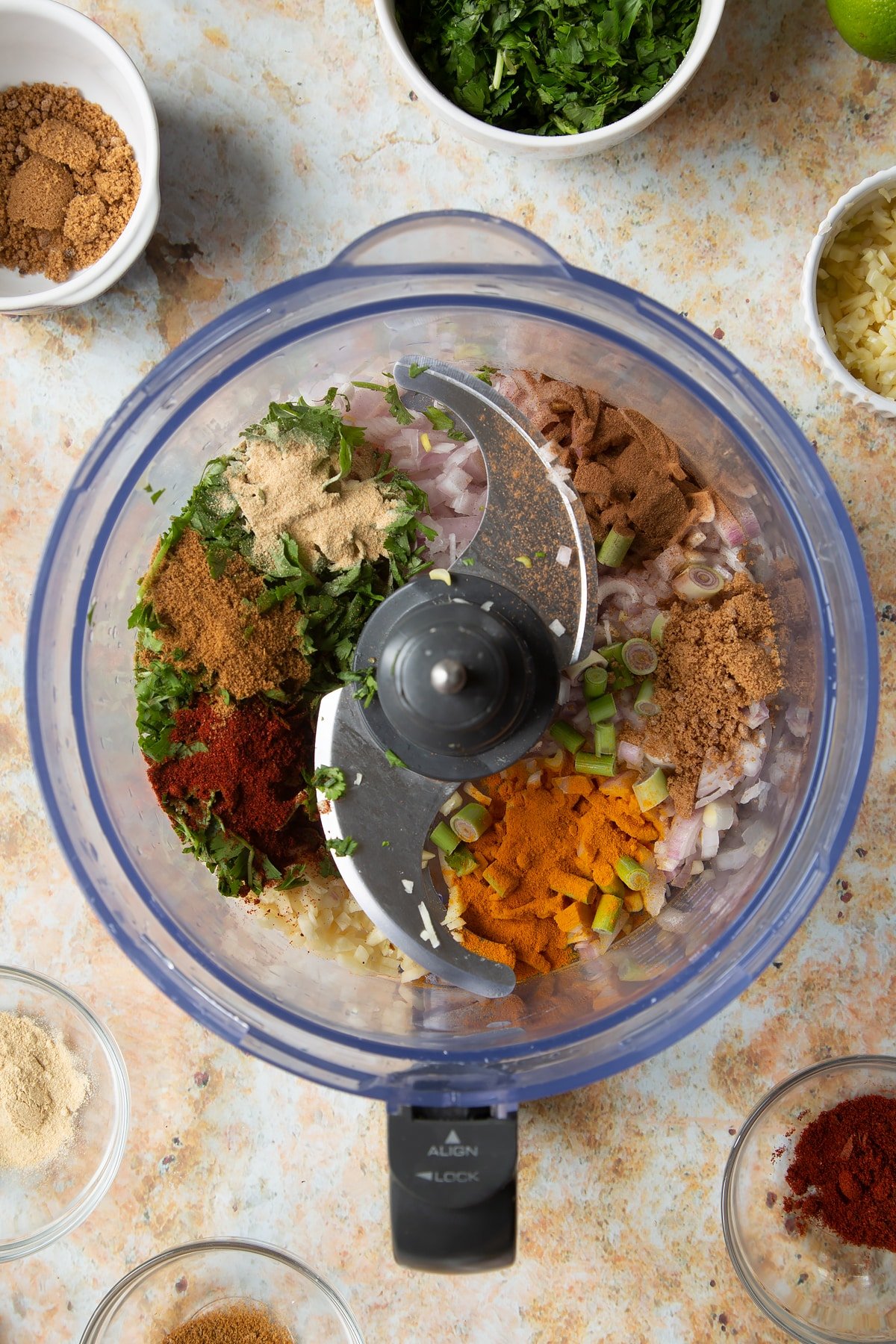
Add the lime juice and soy sauce.
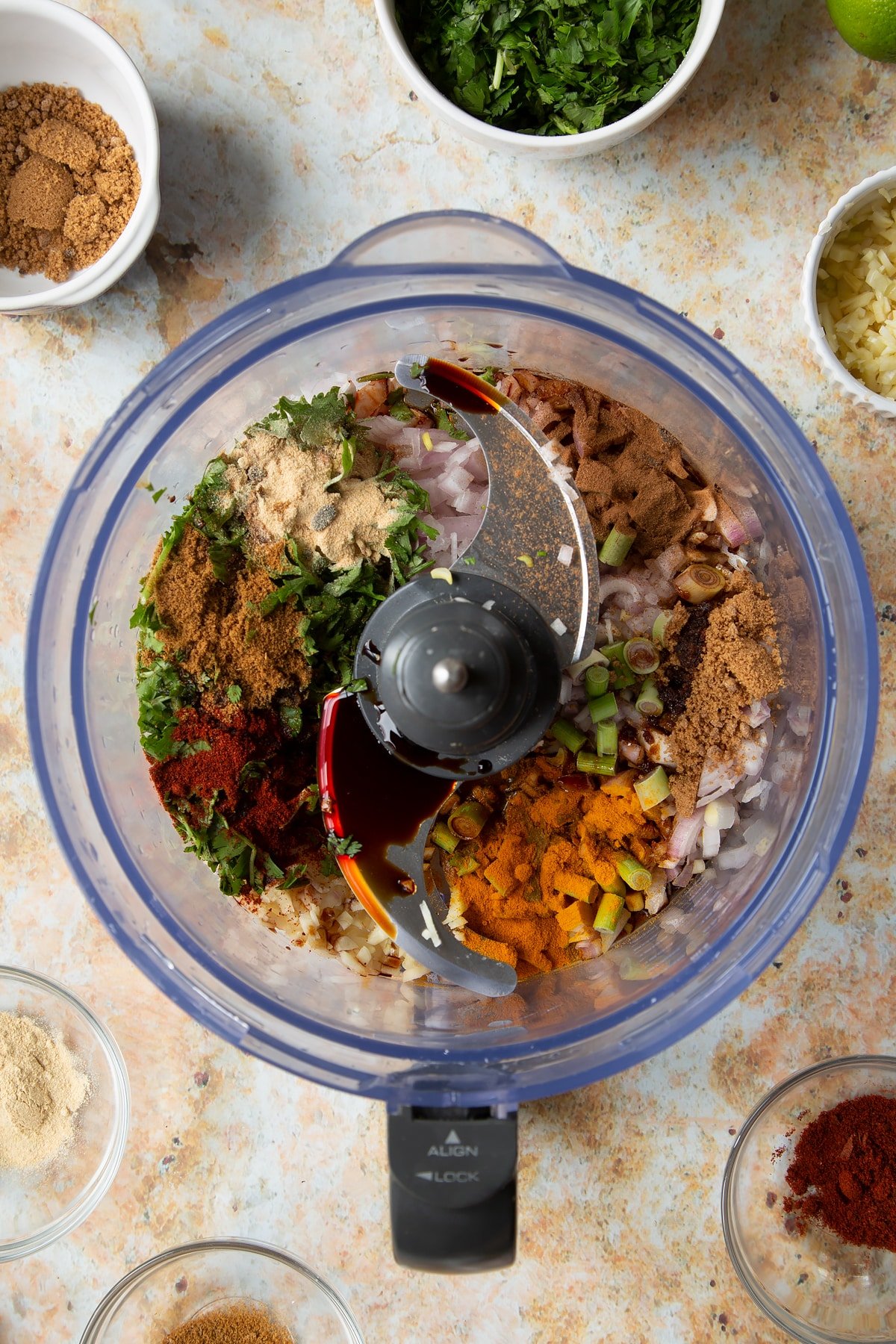
Blitz until you have a yellow paste.
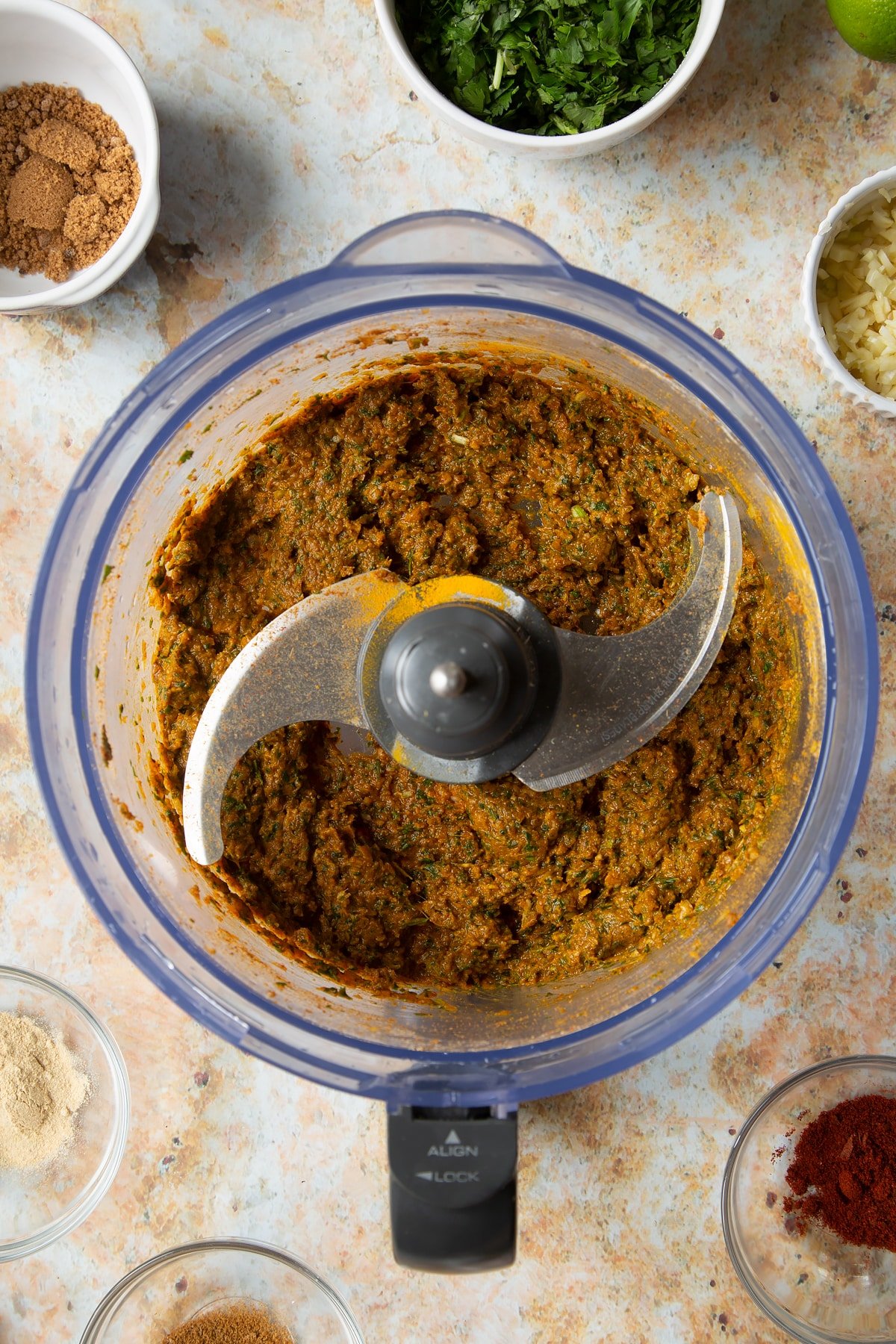
Reserve 2-4 tbsp of curry paste (depending on how strong you'd like your curry). The rest can be chilled and frozen for later.
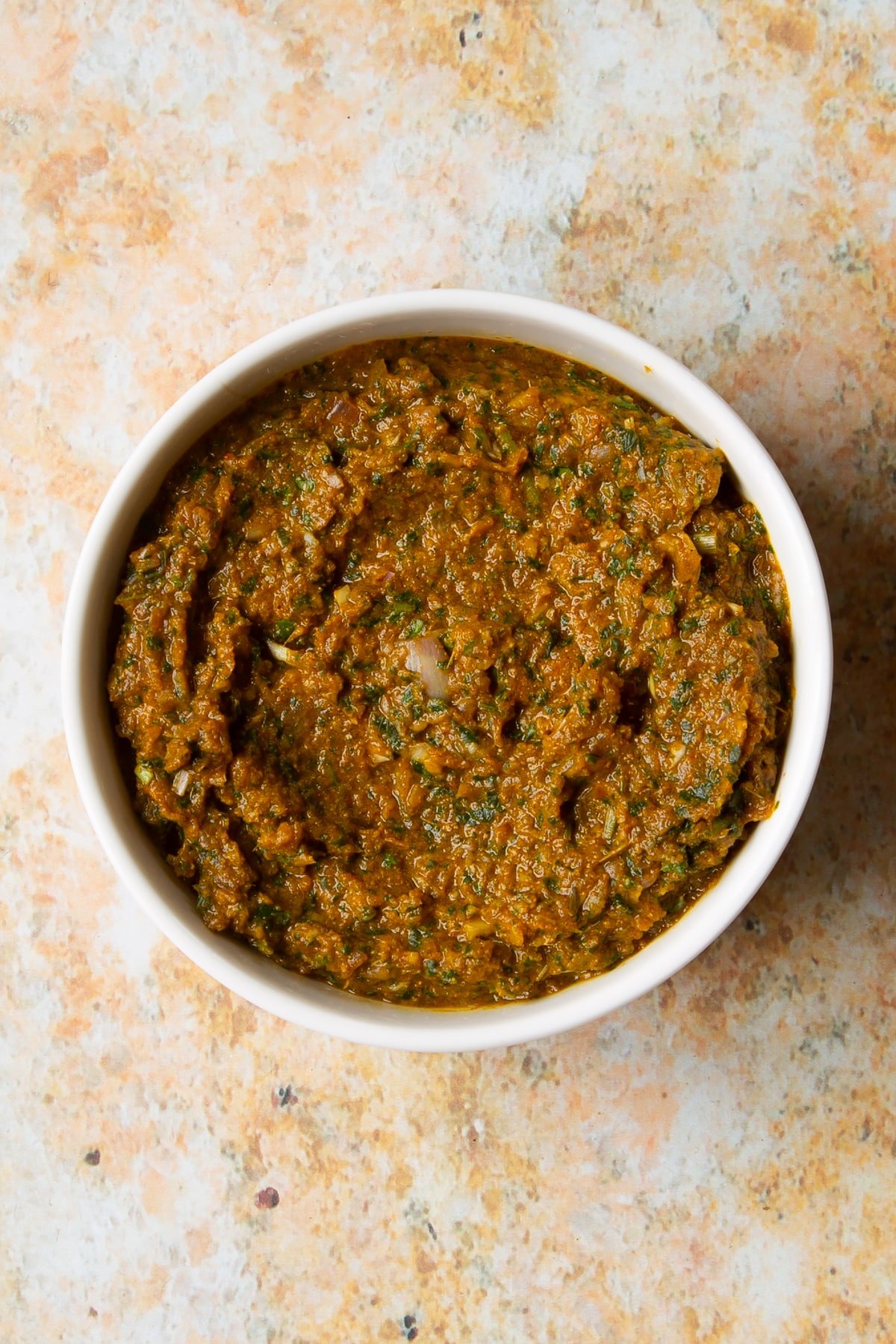
Make the vegetarian yellow curry
Put the potatoes a medium pan.
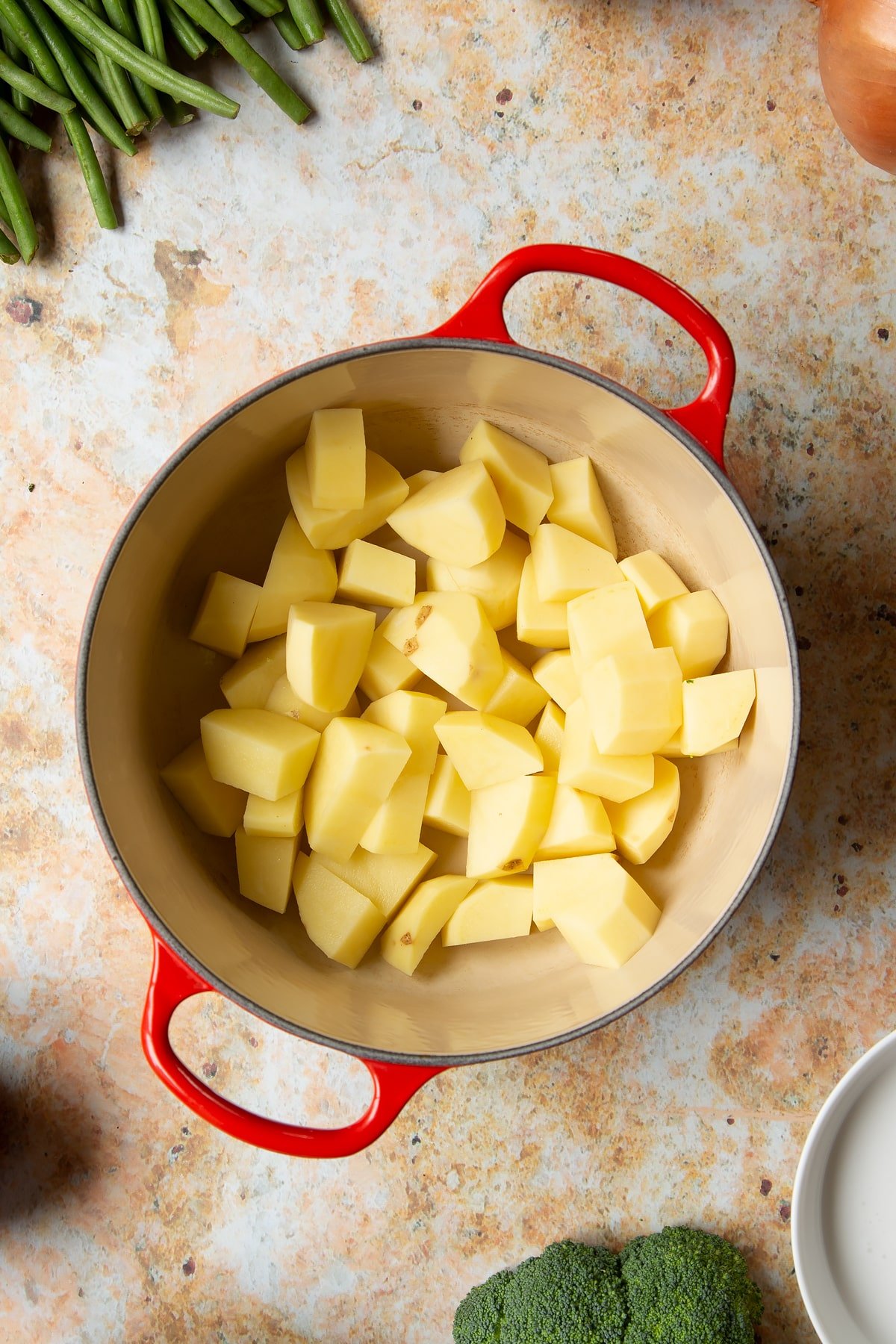
Cover with cold water.
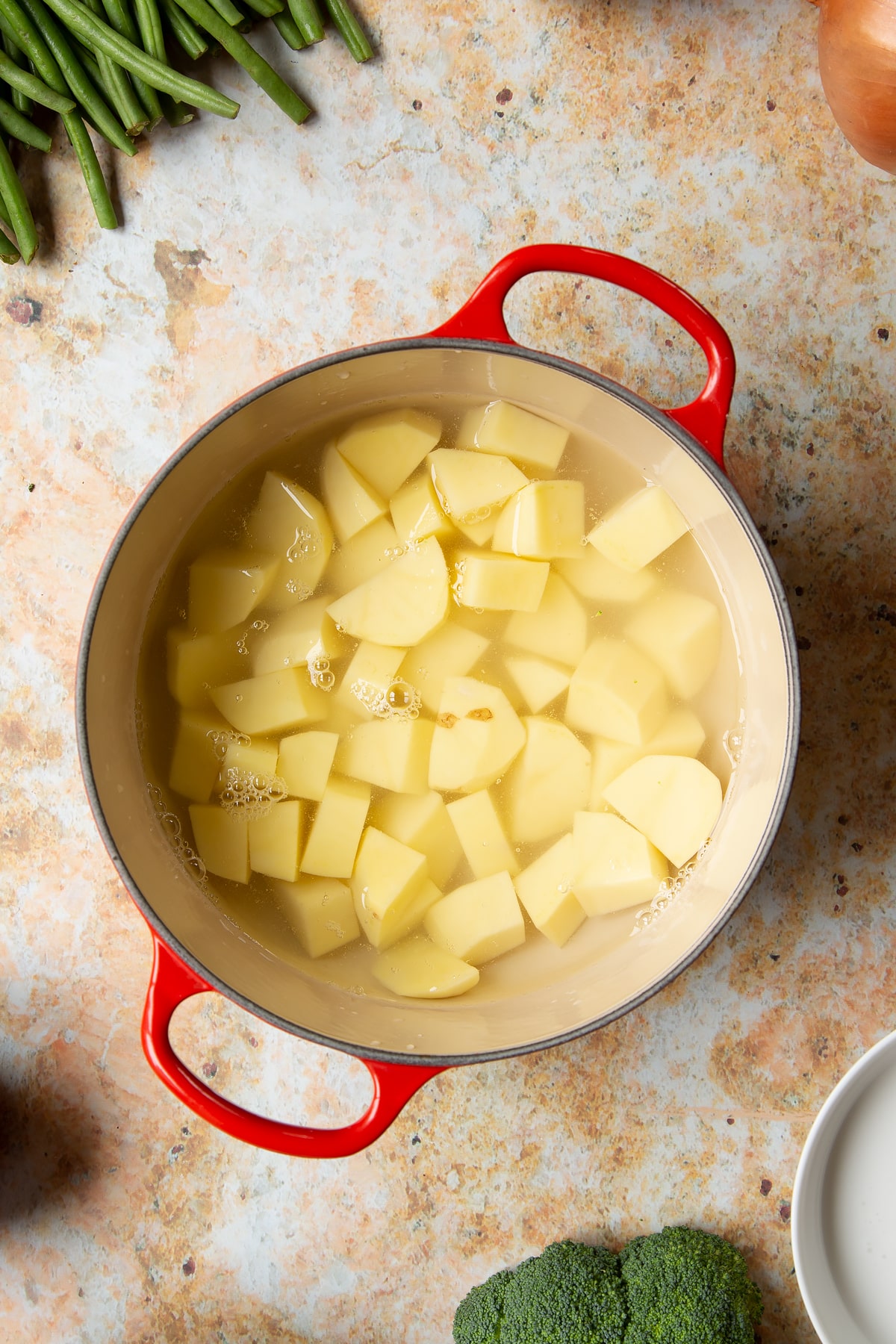
Boil for 5 minutes to start them cooking, drain and set aside until the sauce is ready.
In a large frying pan (one with a lid) heat the oil, then add the sliced onions.
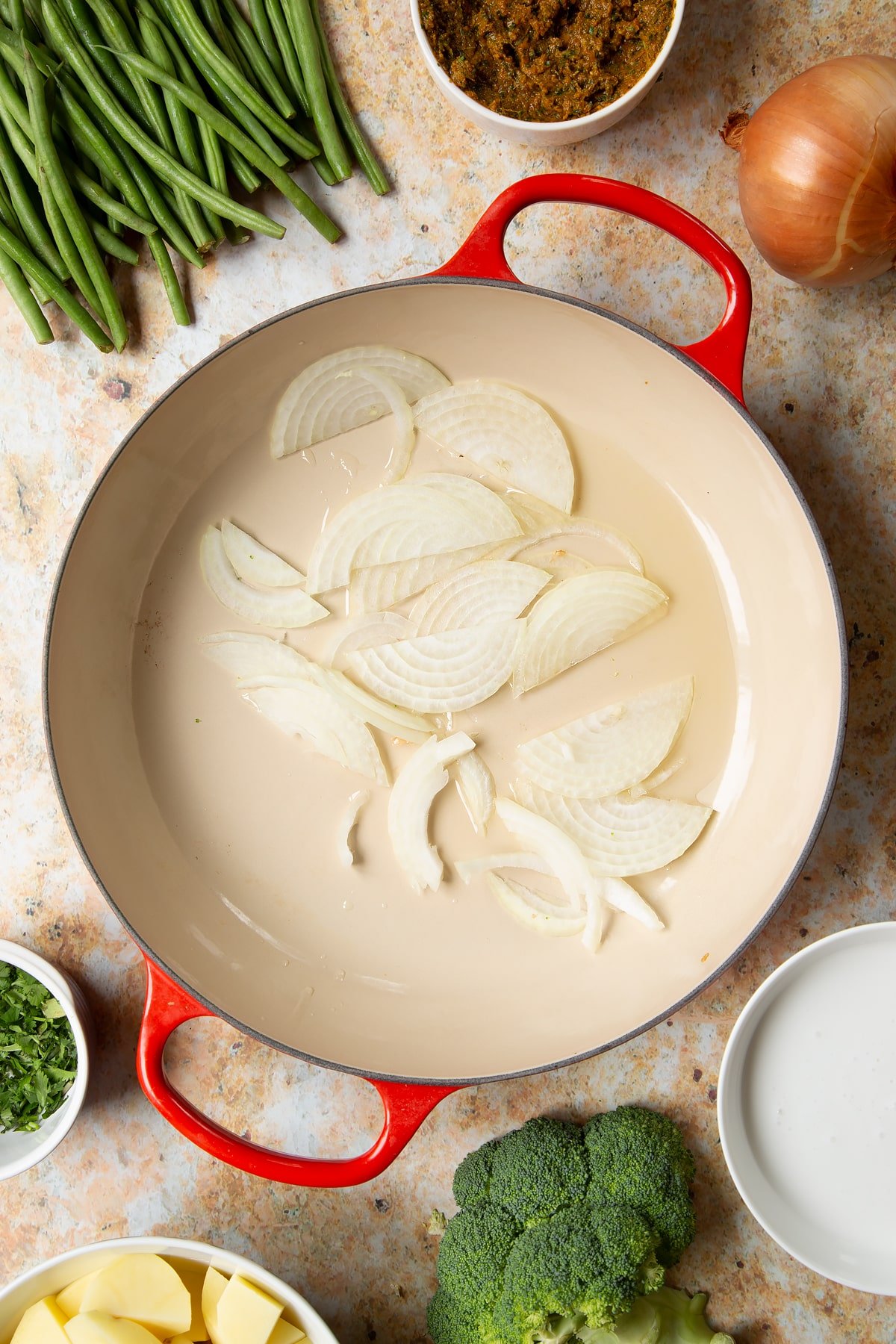
Fry gently for five minutes until beginning to soften.
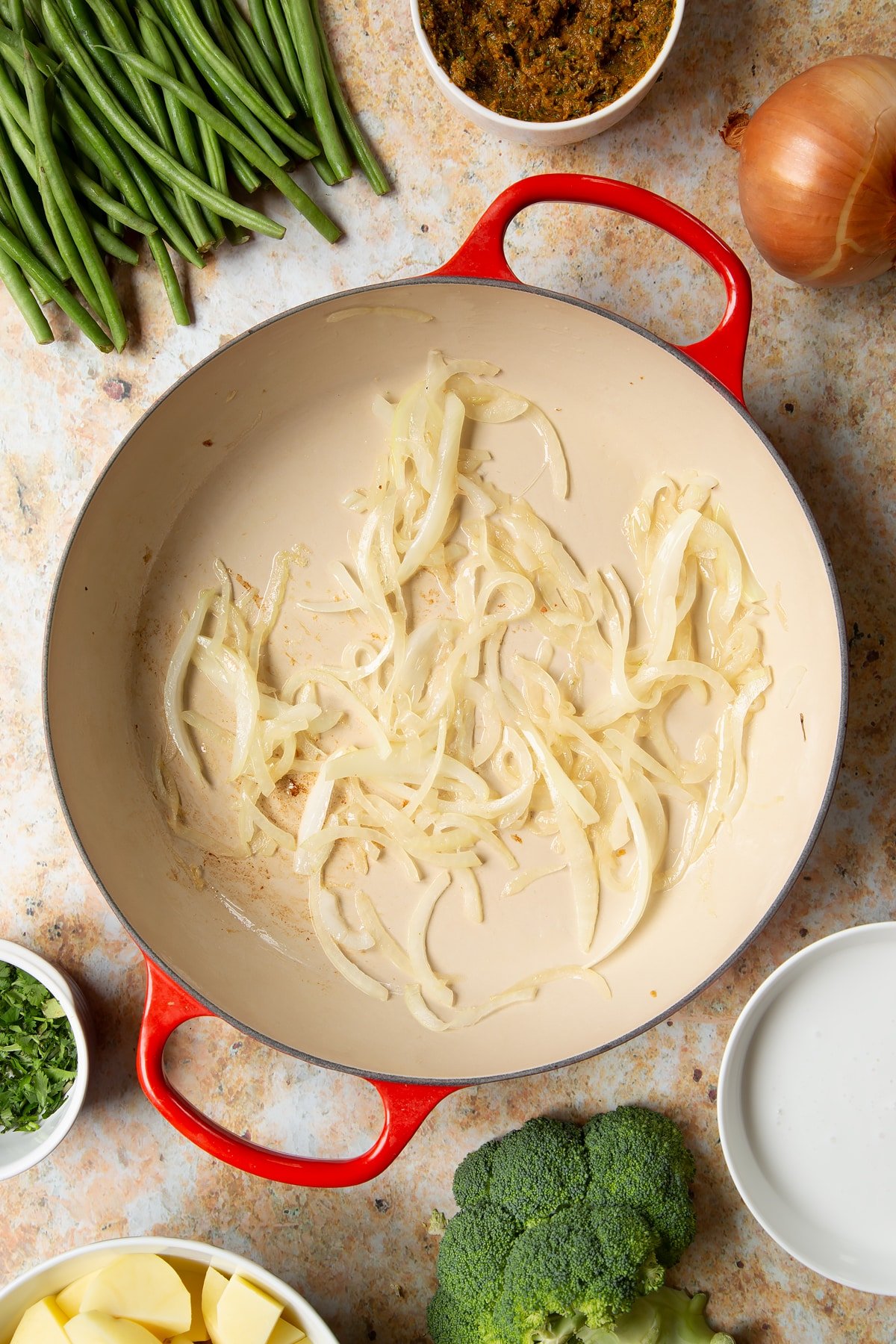
Add 2-4 tbsp of curry paste to the onion and continue to fry for 5 more minutes until the onion is nicely soft and the paste is aromatic.
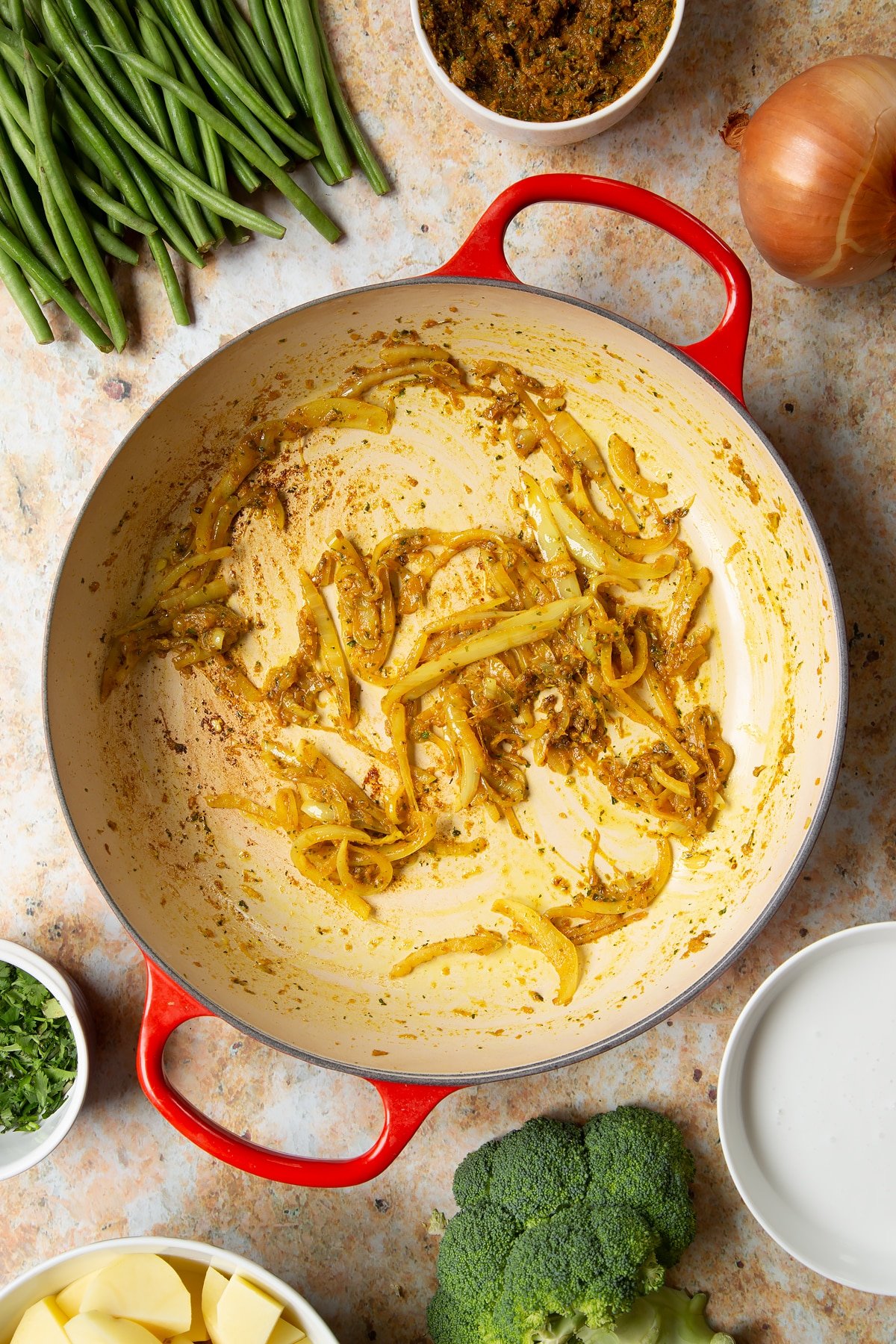
Add the coconut milk.
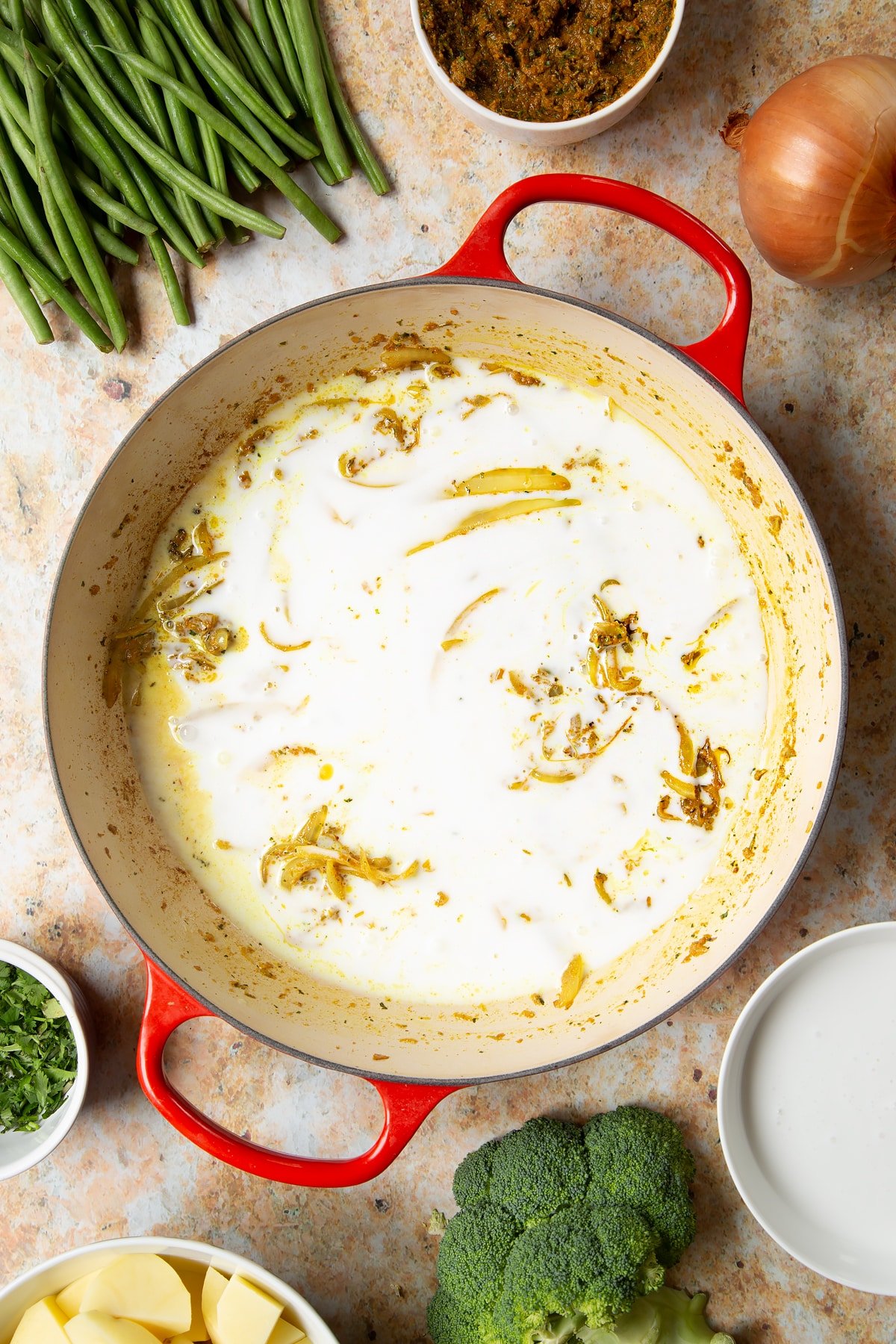
Stir well, taste and season with a pinch of salt and pepper.
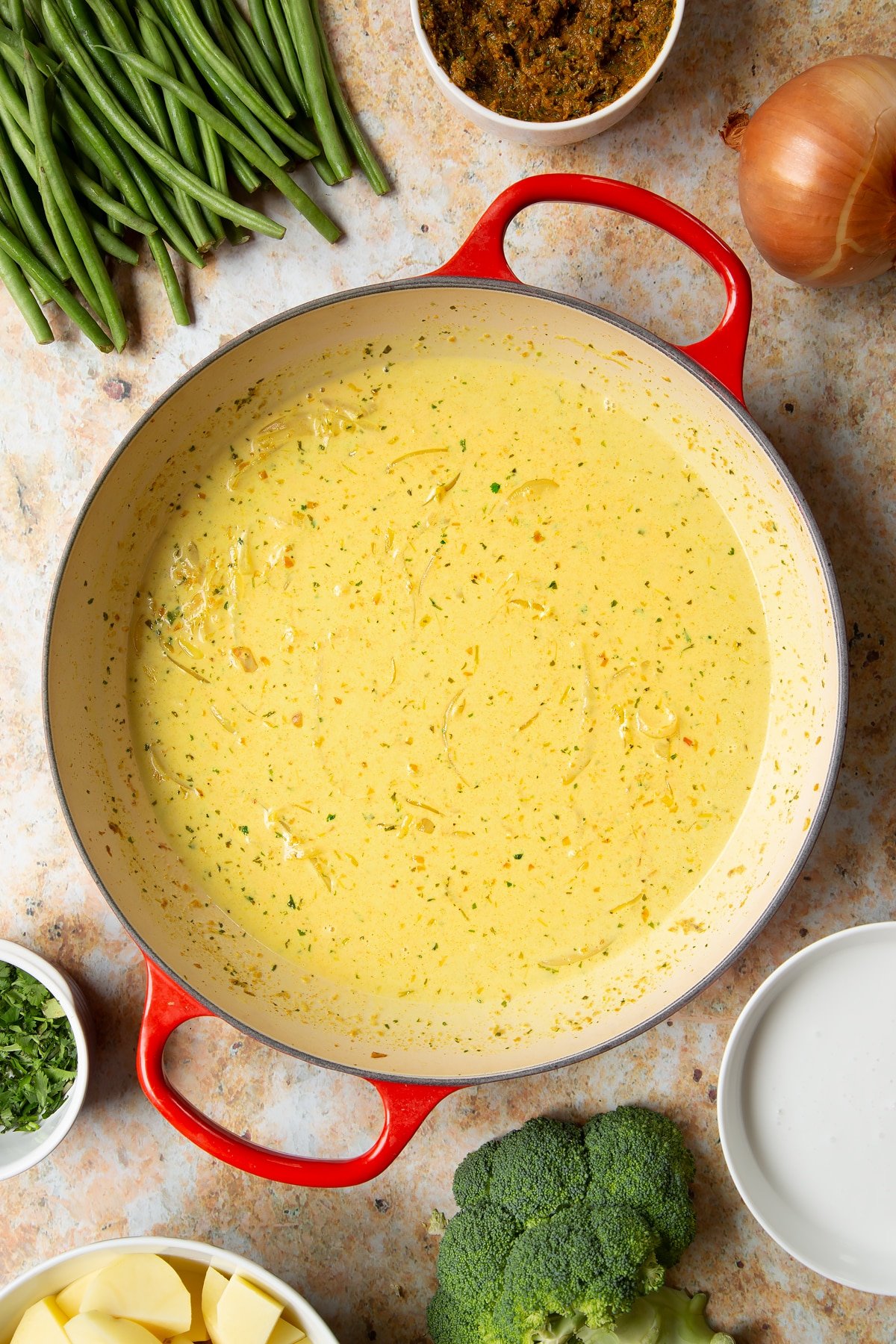
Add the potatoes, broccoli and green beans to the sauce.
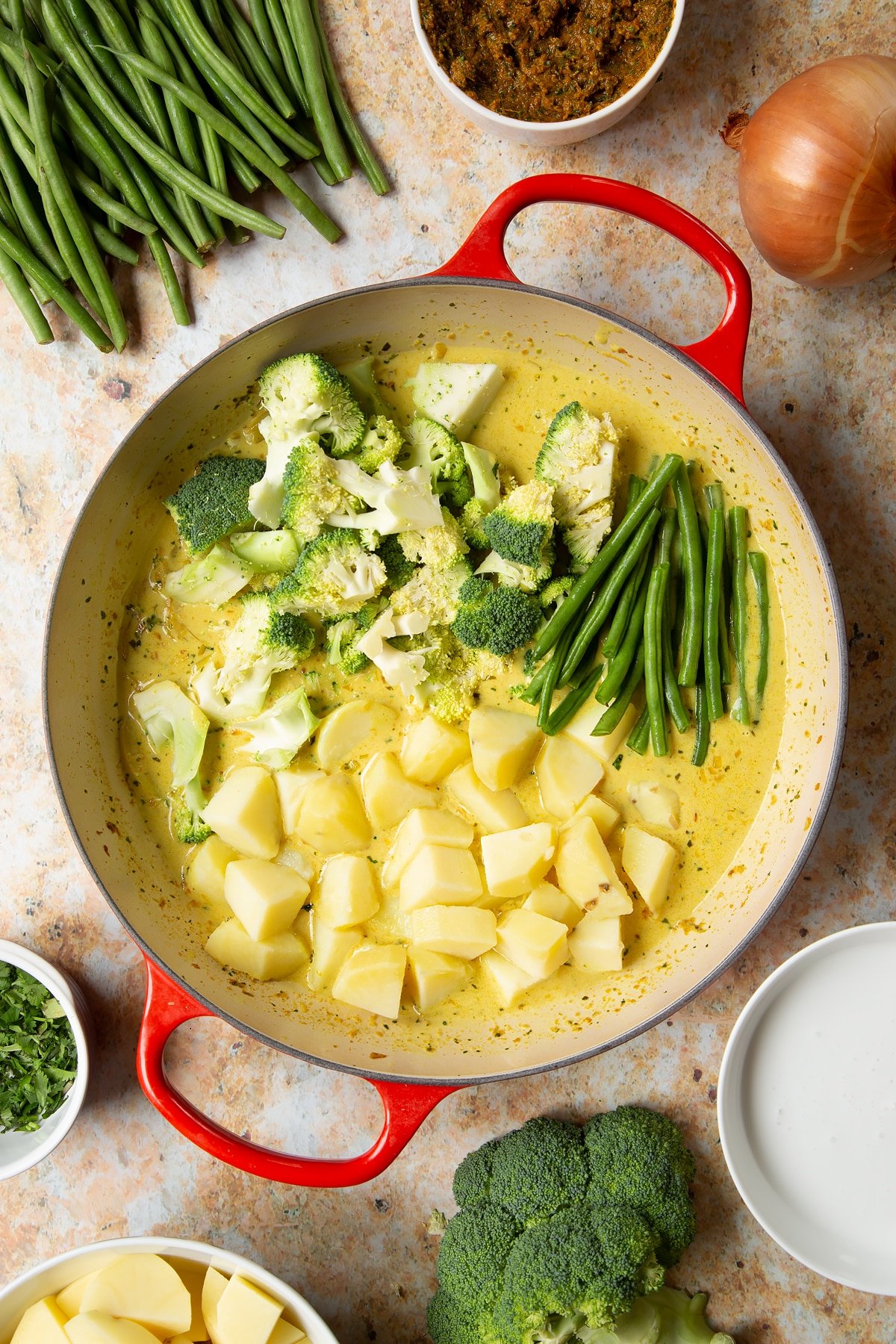
Mix well, cover and simmer for 10 minutes until the potatoes are cooked.
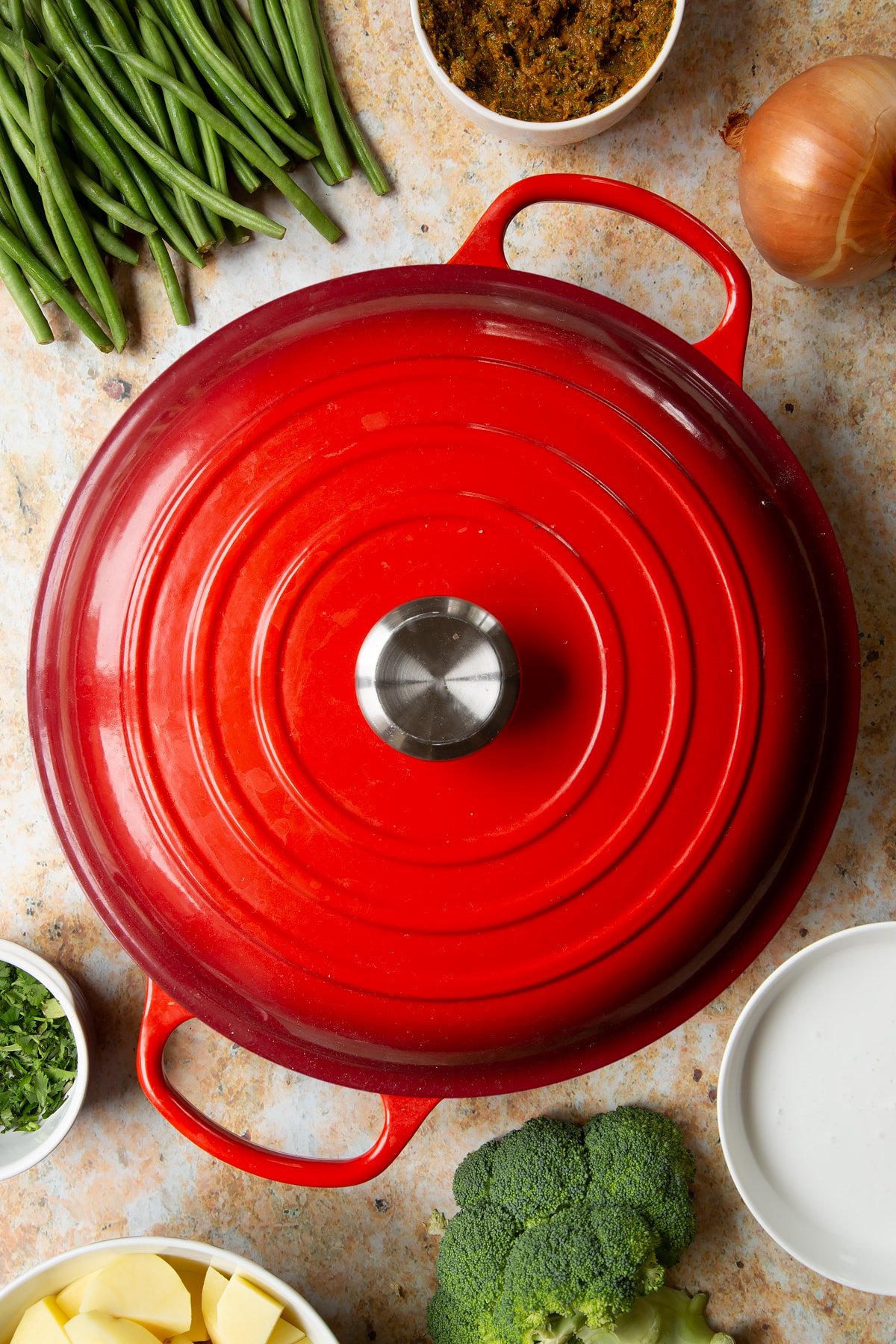
Add a splash of water if your sauce seems too dry.
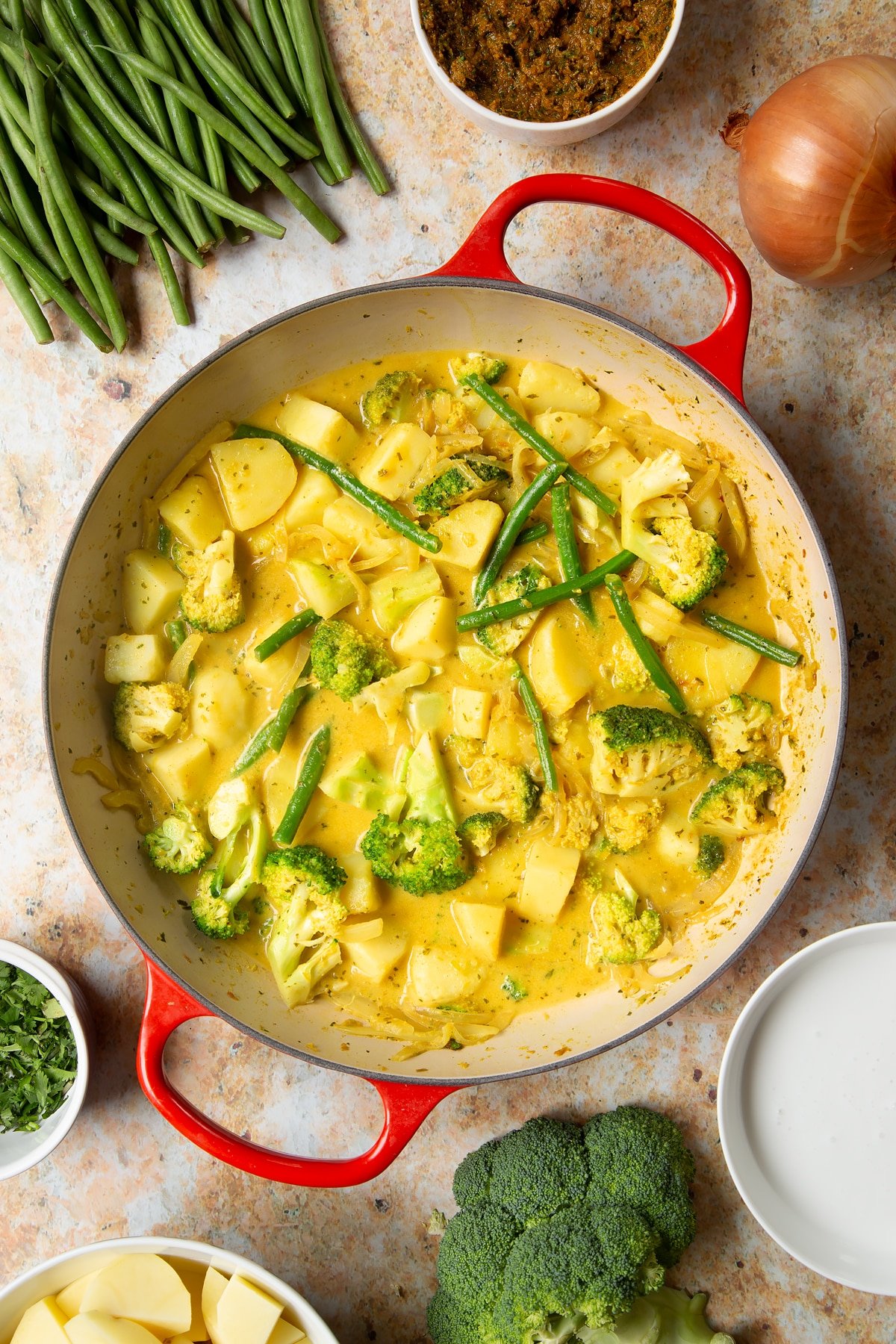
Serve with your favourite rice.
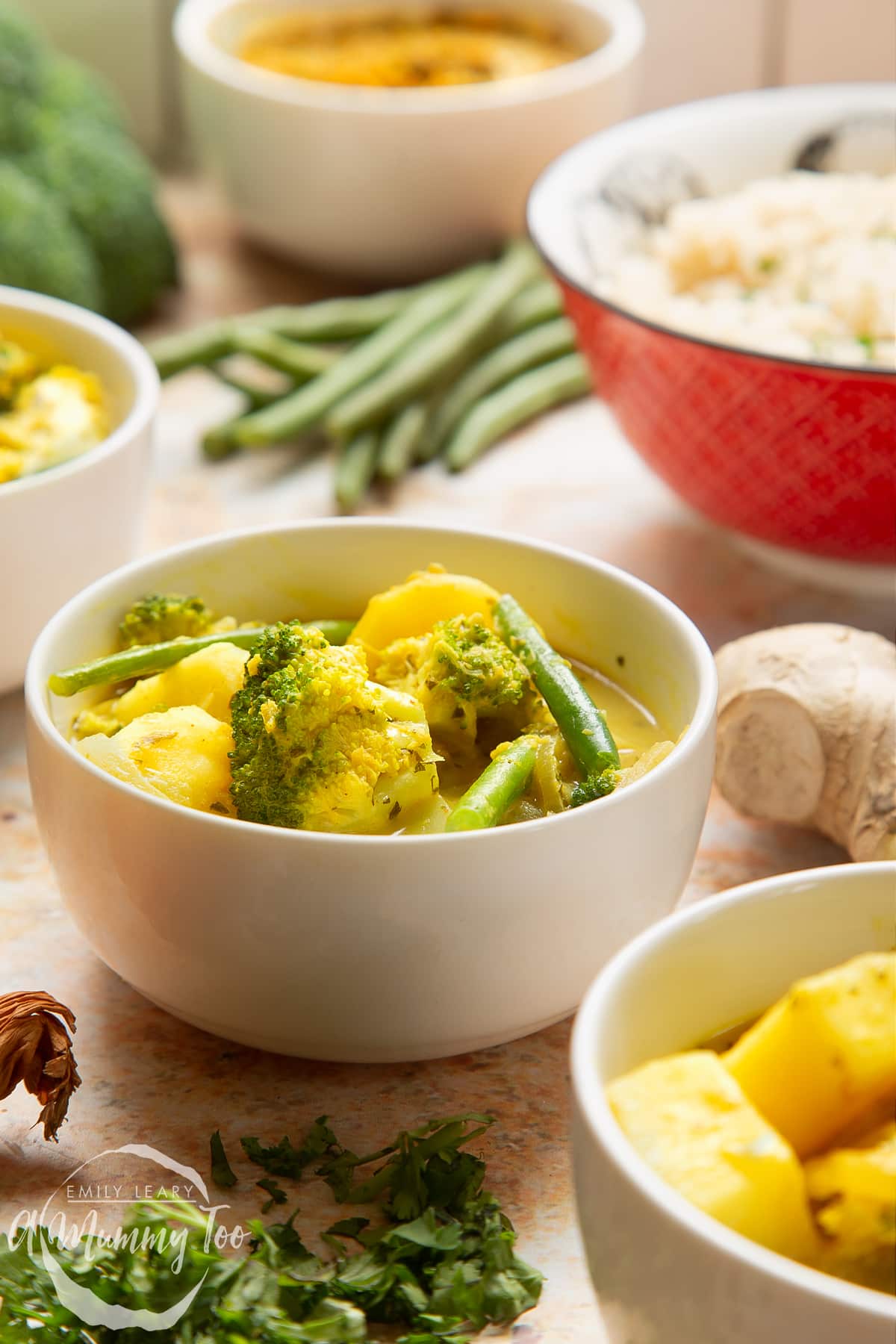
If you're making the recipe regularly, why not experiment with other vegetable combinations? Cauliflower, potato & sweetcorn would be great. Or how about carrot, potato and peppers?
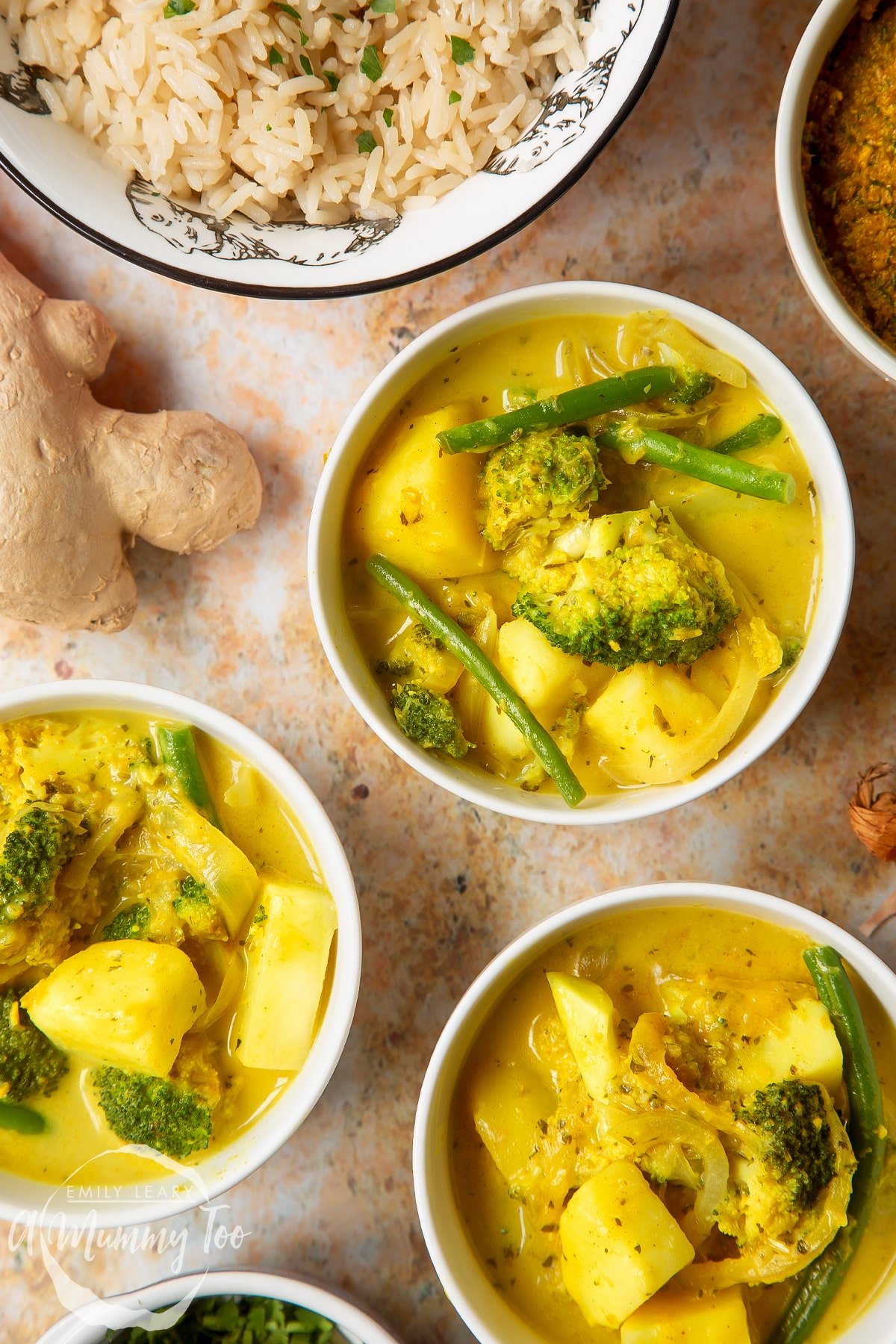
Pointers, tricks and troubleshooting tips for the perfect yellow curry
Is this vegetarian yellow curry easy to make?
Though the ingredients list for the yellow curry paste is quite long, it's still a very easy recipe to follow as you just pop almost everything into the food processor and blitz together.
It's so satisfying to make your own curry paste. You know exactly what's in it and can adjust the flavours to suit you. However, if you'd rather jump straight to making the curry, you could use store-bought yellow curry paste.
Once the paste is made, bringing the dish together is super simple, as you just fry some onions and combine them with the yellow paste, coconut milk and vegetables.
Will I need any special equipment to make vegetarian yellow curry?
You won't need any equipment that you wouldn't find in an average kitchen to create this dish.
The only gadget you'll need is a food processor, but if don't have one, you can chop your garlic, onion, ginger, lemongrass and coriander more finely, bring together with the spices, sugar, lime juice and soy sauce and then use a pestle and mortar to break it down to a paste. You might need to do this in batches depending on the size of your mortar.
If you don't have a mortar and pestle either, then a sharp kitchen knife rocked back and forth over the fresh ingredients for several minutes will also work.
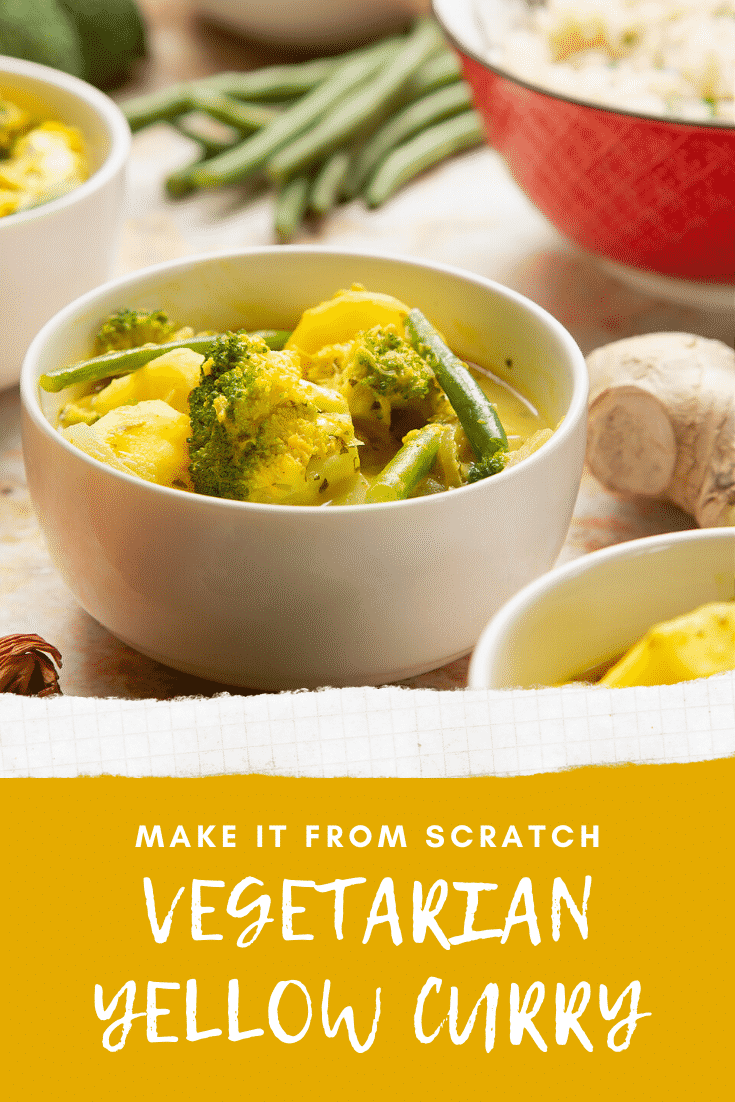
Where can I buy fenugreek?
You should be able to find fenugreek seeds in the spice section of larger supermarkets.
You won't need a whole jar for this recipe, but fenugreek is a great addition to all sorts of vegetable curries and daals, so it's a worthwhile investment for your spice rack.
When can I buy lemongrass?
Fresh lemongrass is stocked by some supermarkets, but it can be slightly tricky to find. If your local stores draw a blank, a visit to your nearest speciality Asian food shop should pay off, or you may have luck finding it in the veg section of your local greengrocers.
Is this yellow curry suitable for a vegetarian or vegan diet?
Yes, this yellow curry is both vegetarian and vegan friendly as it contains no animal products.
It is also a great recipe for people trying to reduce the amount of meat or dairy they consume, as you're unlikely to miss them much in such a tasty curry made with creamy coconut milk.
Is this yellow curry recipe gluten-free?
This recipe contains soy sauce, which will have wheat in, so this curry isn't gluten free.
You can easily switch this for or a gluten-free soy sauce (tamari is almost always gluten-free).
Make sure to check the labelling on everything you use if you're cooking for has a gluten allergy, intolerance or coeliac disease, for example.
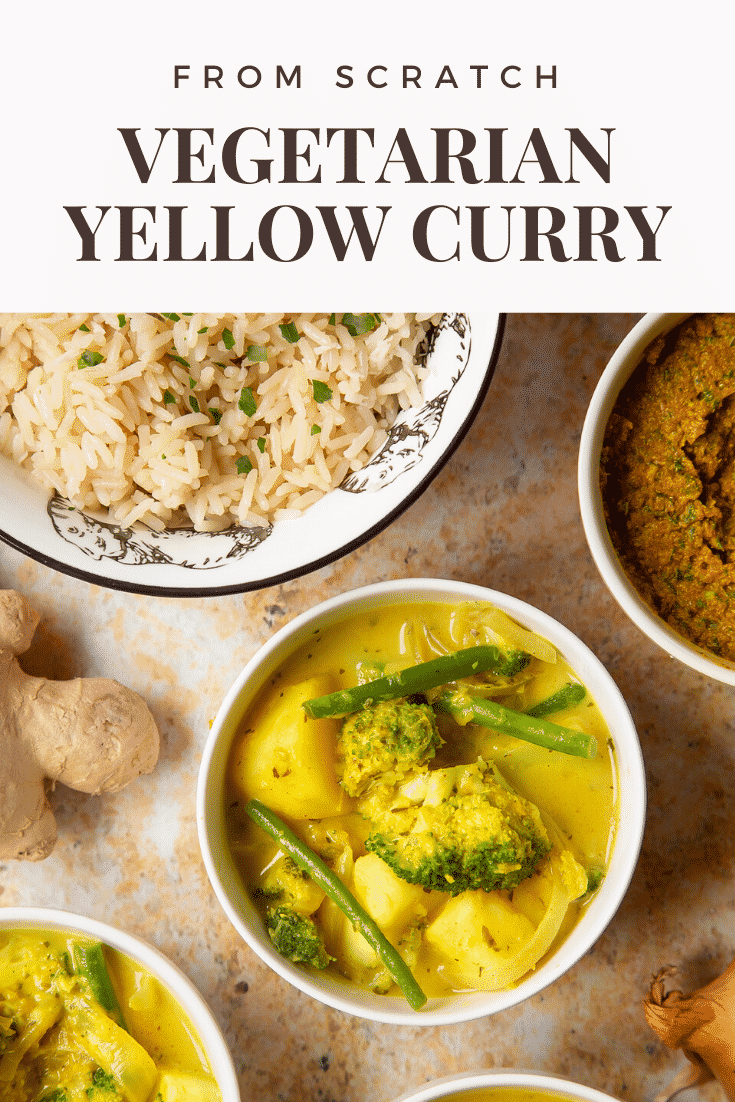
Is this yellow curry recipe keto-friendly?
As one of the main ingredients in this yellow curry is potato, which makes it high in carbohydrate, so it isn't keto friendly.
You could easily switch the potato for cauliflower which will help bring the carbohydrate content down significantly.
Is this vegetarian yellow curry recipe healthy?
As this vegetarian yellow curry is made with broccoli and green beans, it contains a good portion of vegetables per person. The coconut milk means it's relatively high in fat, but you can use reduced-fat coconut milk if you prefer.
All this is a nutritious dish when enjoyed as part of a vegetable-rich, balanced, healthy diet.
Is this recipe safe to eat while pregnant?
Some studies report that fenugreek should be avoided during pregnancy, so please leave the fenugreek out when preparing your curry paste.
There are no other ingredients in this recipe that should pose a risk while pregnant, provided the ingredients are in good condition and have been stored correctly and the recipe is cooked hygienically and safely.
However, this is not a medical advice website. If you're unsure about anything you should always check with your health professional.
The NHS has a great resource that will help review the latest advice regarding foods that are safe to eat while pregnant in the UK.
What goes well with this vegetarian yellow curry?
This vegetarian yellow curry goes with almost any rice but generally, I serve it with white, basmati, jasmine, sticky or brown rice, depending on my mood.
It is also lovely with a few Thai rice crackers to add a crunchy treat.
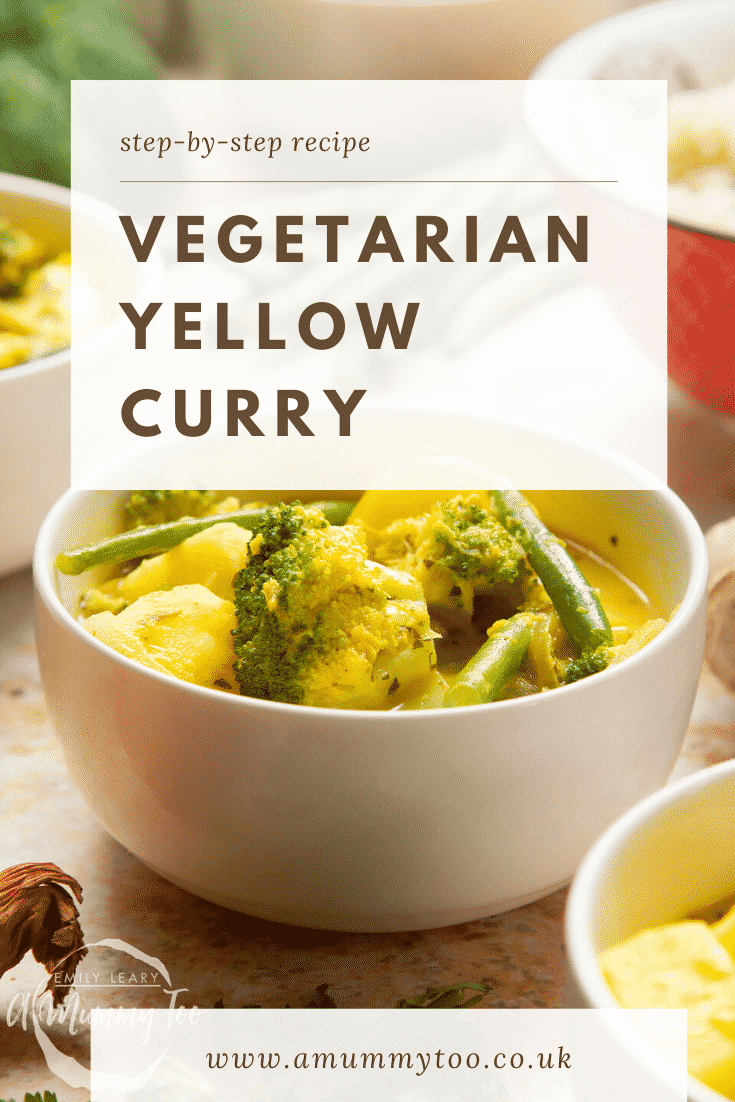
Can I make vegetarian yellow curry without coconut milk?
The coconut milk in this recipe is what creates the delicious creamy sauce.
However, if you are allergic to coconut or don't have any to hand, you could try using plain yogurt, or a dairy alternative yogurt, just be careful not to get it too hot or it will split. Have a look at this reduced-fat Thai green curry, which uses a blend of reduced-fat coconut milk and fat-free yogurt.
Note: I've only tried using coconut milk in this vegetarian yellow curry recipe, so do let me know how you get on in the comments.
Can I add extra spice to this recipe?
Yes, go right ahead. This is quite a mild and warming curry rather than punchy and hot, so if you prefer a little more heat add some chillies.
If you have family members who like different levels of heat, I find it easiest to add fresh chilli or chilli flakes as a garnish for those who do like it spicy - that way, you can keep everyone happy!
Can I make this vegetarian yellow curry ahead?
You can most certainly make the paste ahead of time, in fact I like to double the mix so I have a few pots in the freezer ready to go.
If you're planning to cook the full vegetarian yellow curry ahead of time, make sure not to cook the potatoes too long, as when you reheat they will cook further and could quite quickly turn to mush.
How should I store my vegetarian yellow curry? How long will it keep?
This recipe should be cooled to room temperature and put into the fridge in an airtight container within two hours of cooking.
If stored correctly, this vegetarian yellow curry will keep in the fridge for up to 3 days.
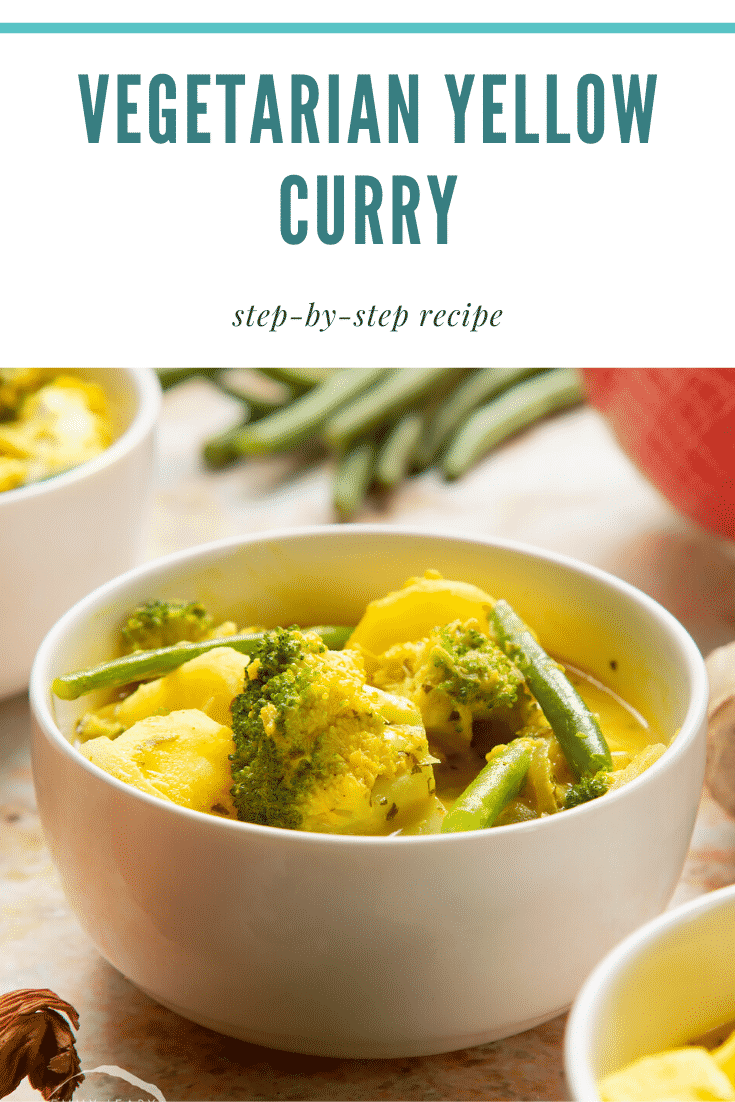
Can I freeze vegetarian yellow curry?
Yes, this recipe is great to freeze, either just the paste or as a finished meal.
Make sure you get the paste into pots and into the freezer as quickly as possible.
If freezing the finished curry, cool it down and pop it into a freezer-safe, sealed container and into the freezer within two hours of cooking.
Both the paste and the curry will keep in the freezer for up to two months when properly stored.
Do be careful not to overcook your potatoes if you know you'll be freezing some as when overcooked, they have a tendency to turn to mash when you come to reheat the dish.
What is the best way to reheat vegetarian yellow curry?
This vegetarian yellow curry can be reheated in the microwave from the fridge or from frozen.
If your fridge/freezer container is microwave-safe, simply crack a corner open.
If your container isn't microwave-safe, transfer the curry to a microwave safe-dish and partially cover with a lid if you have one available.
Cook on full power in 1 minute, checking, stirring and repeating until warmed through. Don't stir too much at first if it's frozen as you'll break the vegetables up.
You can also reheat the dish on the hob, adding a tablespoon or two of water and using a lid so that it doesn't burn or stick, especially if cooking from frozen. Use a low heat and stir occasionally until fully warmed through.
If you also plan to reheat rice, it's vitally important than you've stored your rice correctly in the first place, as incorrectly stored rice is a common source of food poisoning that is not removed by heating tainted rice.
Make sure that you've:
- Cooled the rice down and got it in the fridge within an hour of making it.
- Stored the rice in the fridge for no more than a day.
- Made sure it's piping hot once reheated.
- Has only been reheated once before being eaten.
This is only guidance, not medical advice. This NHS article on rice poisoning offers more information.
Can I make this vegetarian yellow curry in a different quantity?
It’s very easy to adjust this recipe to make more or less vegetarian yellow curry.
Simply scroll down to the recipe card towards the bottom of this post and hover your mouse (or tap your finger) over the portion number.
You will then be shown a slider, which you can move up and down to change the number of portions the recipe will make. As you do so, all of the ingredient quantities will automatically change accordingly.
If you have any questions about changing the quantities, just ask!
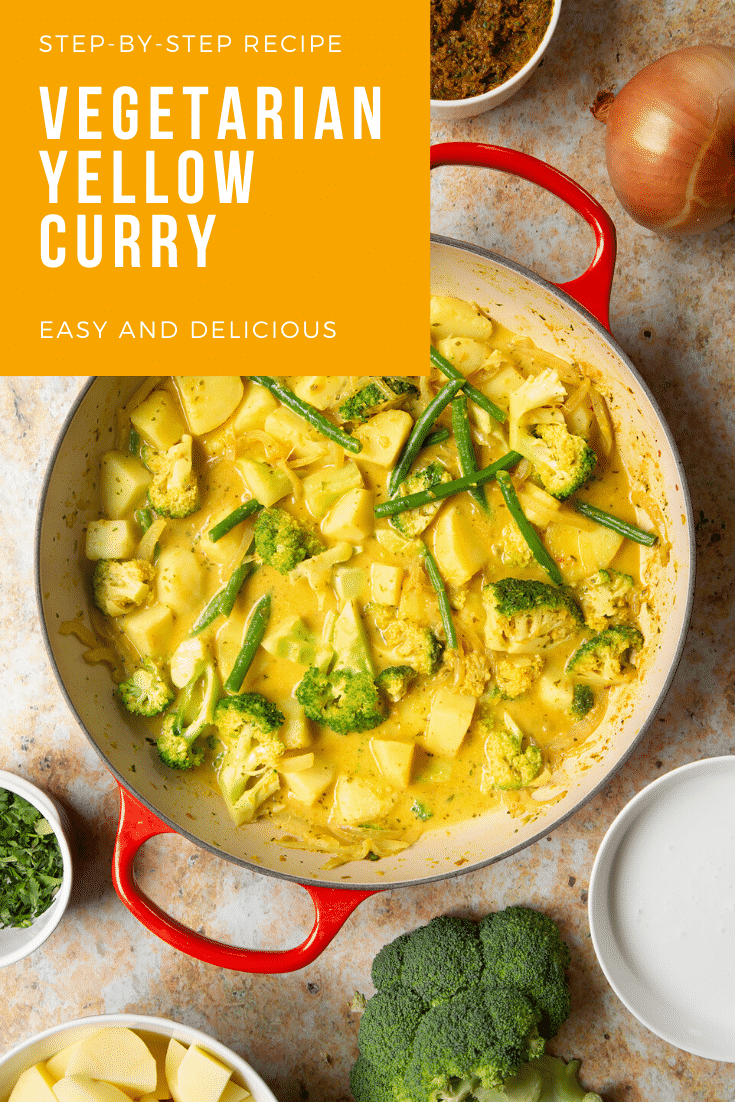
How can I make sure my vegetarian yellow curry is perfectly cooked?
The main thing about this dish is to make sure the potatoes are cooked all the way through before serving. The easiest way to check for this is to push a fork or skewer into a potato - if you encounter any resistance then let it simmer for a few more minutes.
Try not to do this too often as the potatoes that have been forked will lose a little of their structure as they continue to cook.
Why did my vegetarian yellow curry turn out thin/watery?
Different brands of coconut milk will have different amounts of fat in them, which will affect the consistency of the dish. If you notice a large amount of fat still stuck to the lid or sides of your can of coconut milk make sure you scrape it off and add it into the dish.
If you would like a thicker yellow curry, you can simmer the dish for longer or use less coconut milk.
If simmering for longer, I would use a wide, shallow pan as the larger surface area will mean the sauce can evaporate quickly without overcooking the veg. Avoid simmering for too long once you have added the veg in any case, as this could mean your veg become mushy.
Why did my sauce turn out so thick?
This is naturally quite a thin sauce, but if you find your vegetable yellow curry sauce is too thick, you can thin it out further by adding more coconut milk or a splash of water.
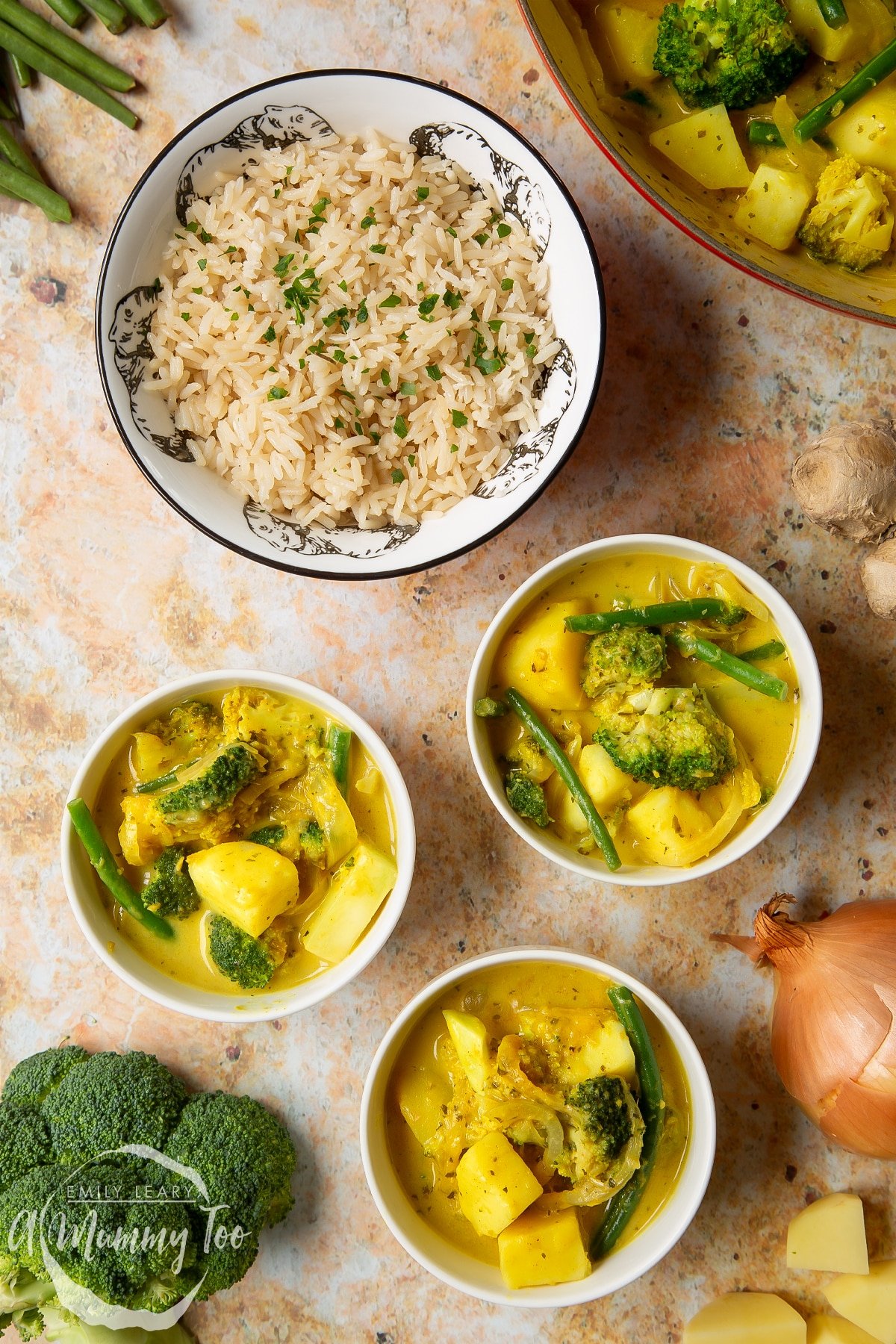
How can I change the flavours in my vegetarian yellow curry?
I think the spices are very well balanced for this dish. However, if you like a bit more heat, you could try adding a little ginger and cayenne pepper to the curry paste mix, or wait until the end and add chopped fresh red chilli to taste.
You can also experiment with different vegetable combinations. Sweet potato, peppers, carrots, cauliflower...whatever is in your fridge, really!
You'll be surprised how much difference it can make to the same base curry.
Print this vegetarian yellow curry
Vegetarian Yellow Curry Recipe
Ingredients
For the vegetarian yellow curry paste
- ½ (1/2) onion roughly chopped
- 15 g (0.5 oz) fresh root ginger peeled and chopped
- 2 cloves garlic
- 15 g (0.5 oz) fresh coriander (cilantro) roughly chopped including stalks
- 1 stick lemongrass roughly chopped
- ½ tsp (1/2 tsp) ground cumin
- 1 tsp turmeric powder
- ½ tsp (1/2 tsp) fenugreek
- ½ tsp (1/2 tsp) cayenne pepper
- ¼ tsp (1/4 tsp) cinnamon
- 1 tsp soft light brown sugar
- ½ (1/2) lime juiced
- ½ tbsp (1/2 tbsp) soy sauce or gluten free alternative
For the vegetarian yellow curry
- 1 tbsp vegetable oil (canola oil)
- ½ (1/2) onion peeled and thinly sliced
- 400 g (14.1 oz) canned coconut milk
- ½ head (1/2) broccoli chopped into florets including the stalk
- 2 medium potatoes peeled and chopped into bitesize pieces
- 75 g (2.6 oz) green beans topped and tailed
- Pinch salt and black pepper
Instructions
Make the vegetarian yellow curry paste
- Put the onion, ginger and garlic into a food processor.
- Add the coriander and lemon grass.
- Add the cumin, turmeric, fenugreek, cayenne pepper, cinnamon and brown sugar.
- Add the lime juice and soy sauce.
- Blitz until you have a yellow paste.
Make the vegetarian yellow curry
- Put the potatoes a medium pan.
- Cover with cold water.
- Boil for 5 minutes to start them cooking, drain and set aside until the sauce is ready.
- In a large frying pan (one with a lid) heat the oil, then add the sliced onions.
- Fry gently for 5 minutes until beginning to soften.
- Add half to all of the curry paste to the onion and continue to fry for 5 more minutes until the onion is nicely soft and the paste is aromatic.
- Add the coconut milk.
- Stir well, taste and season with a pinch of salt and pepper.
- Add the potatoes, broccoli and green beans to the sauce.
- Mix well, cover and simmer for 10 minutes until the potatoes are cooked.
- Add a splash of water if your sauce seems too dry.
- Serve with your favourite rice
Video
Notes
Nutrition
Pin this vegetarian yellow curry for later
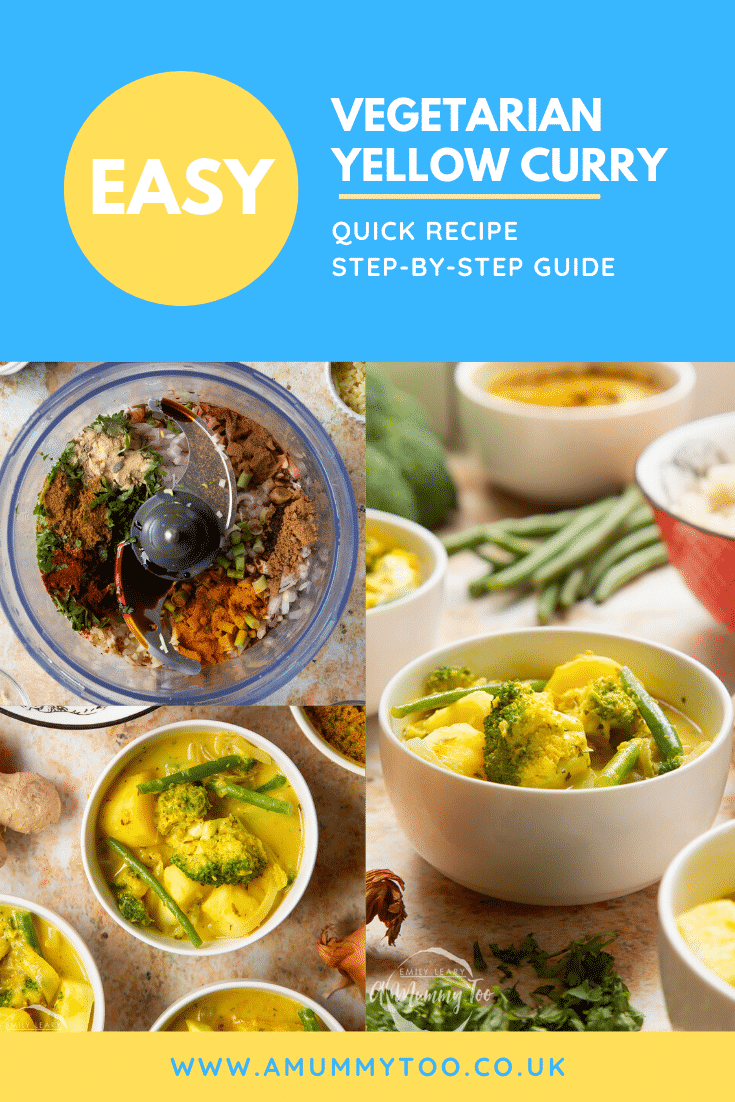
More curry recipes to try
Have you got my book?
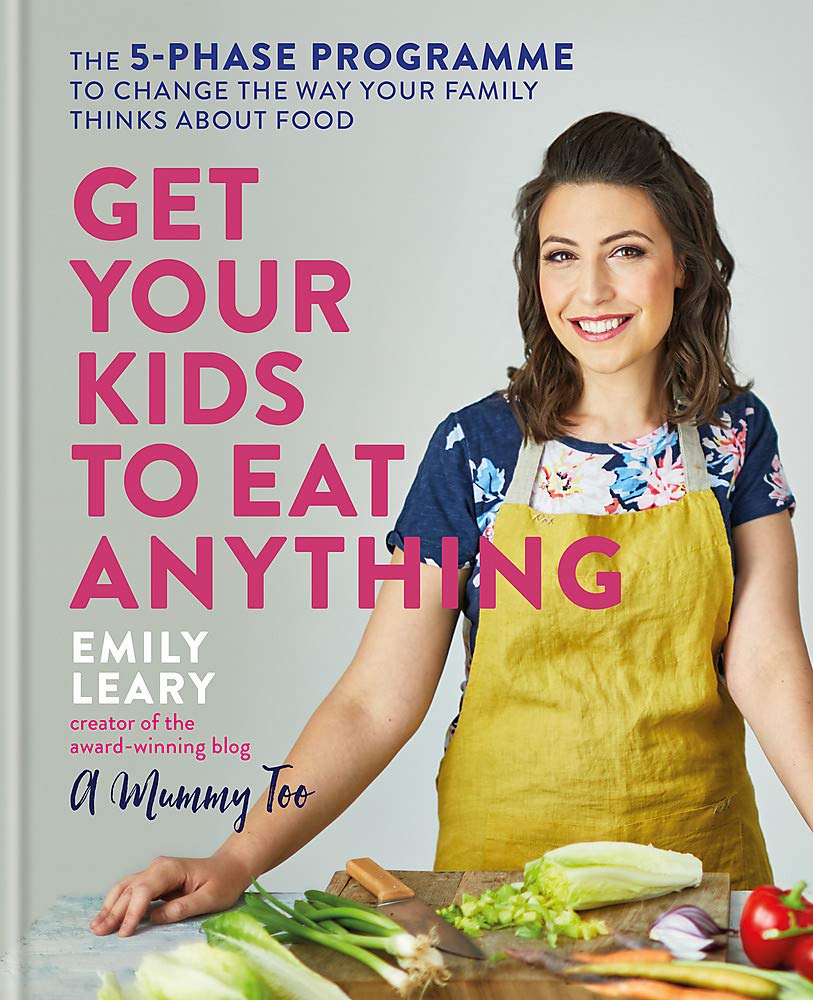
'This is a great kids cookery book. Emily is a star' - Simon Rimmer
'The book I'd like to force into any mother's kitchen' - Prue Leith
"A fab book with a plan." - Jane Devonshire, 2016 Masterchef UK winner
'Emily has managed to combine her mummy knowledge and passion for food to make a truly helpful and brilliant cookbook' - Priya Tew, RD, BSc (Hons), Msc
Get Your Kids to Eat Anything is an achievable 'how to' for parents in the battle to overcome picky eating and 'make new the norm'. Emily Leary's unique 5-phase programme looks at the issue of 'fussy eating' in a holistic way that links imagination with food, and which situates parents alongside - not in opposition to - their children.

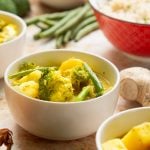
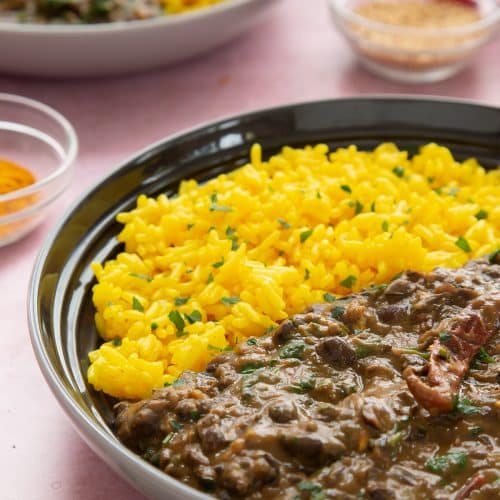
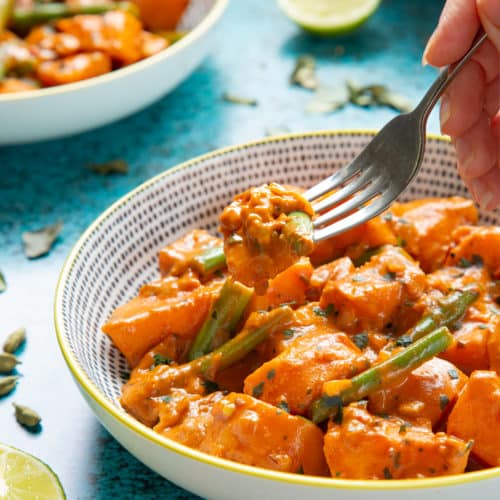
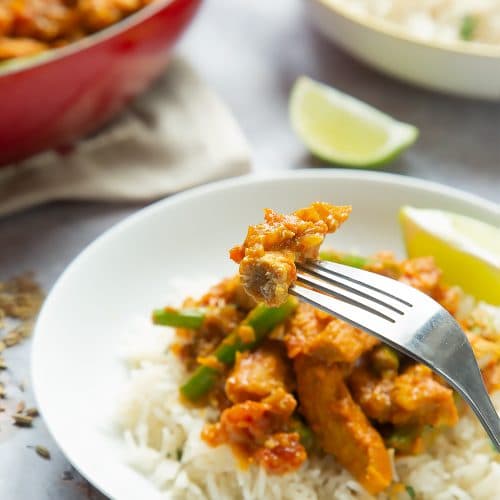
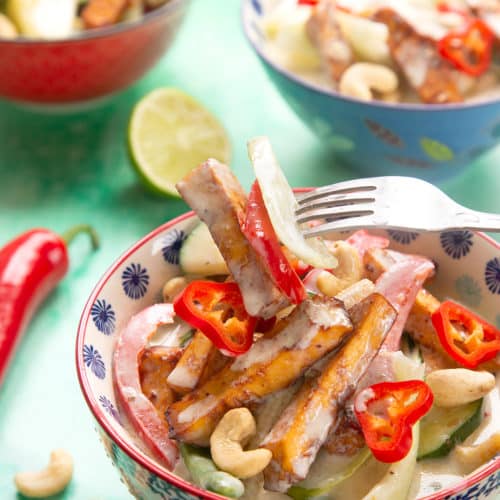
Leave a Reply